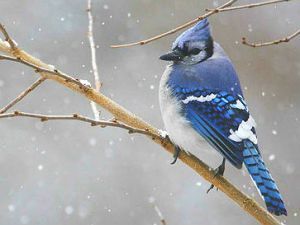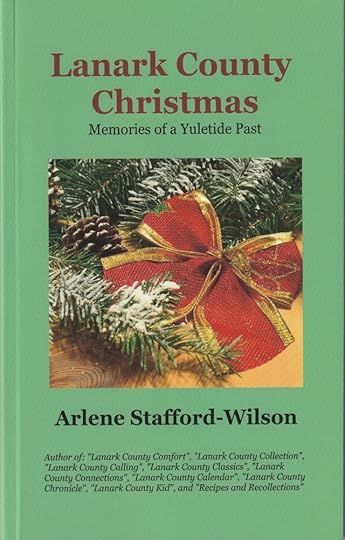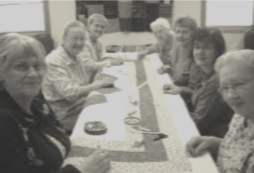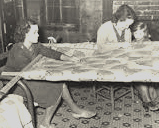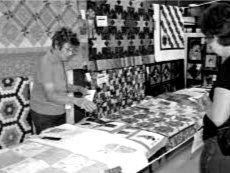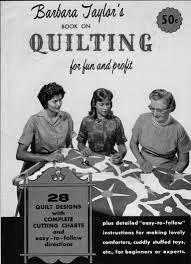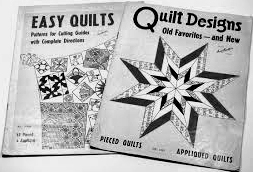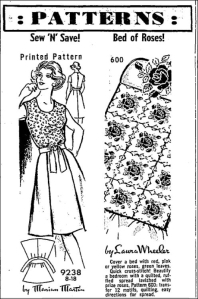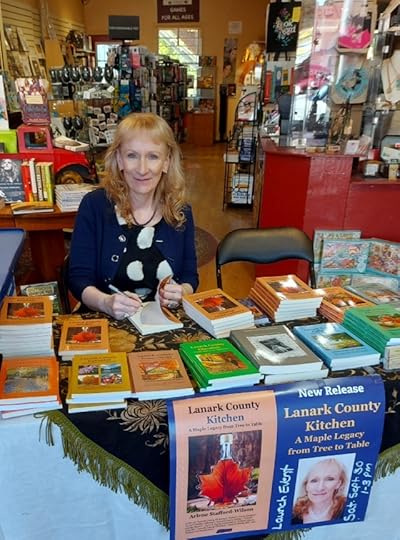Arlene Stafford-Wilson's Blog, page 12
January 16, 2024
January Feast at Mother’s Birdfeeder
There was nothing fancy about the rickety old wooden bird feeder in the orchard behind the house. Our father was not going to win any awards for his design, that’s for sure. The bird feeder was constructed of five short pieces of wood, cut from an old weathered plank, and consisted of a floor, a roof, and three side walls. The pieces were nailed together, and mounted on a two by four, hammered into the ground, about twenty feet from the back kitchen window.
It was Mother who requested that the feeder be built one winter. It had been a brutally cold January, and snowy too. The winds from the north seemed particularly harsh that year, and it had been weeks since I’d ventured up the Third Line to visit my friends at DeWitt’s Corners. I’d been outside a few times helping with the shoveling, and even slid down our neighbour Chris Perkins’ hill on my toboggan a couple of times, but it was just too cold to stay outside for very long.
Because of the heavy snow and frigid temperatures, Mother had been very concerned that the birds wouldn’t be able to find food and would perish. Once Dad had finished putting up the bird feeder, Mother went to straight to work preparing something she thought would be hearty and filling for her feathered friends.
She brought out the heavy, well-worn, cast iron frying pan from under the sink, went straight to the old refrigerator, and picked up her bowl of bacon drippings. Every time Mother cooked bacon she poured the leftover drippings into a melamine bowl, and stored it in the fridge. She used the drippings to add flavour whenever she fried eggs, and for frying onions to have as a side dish with supper.
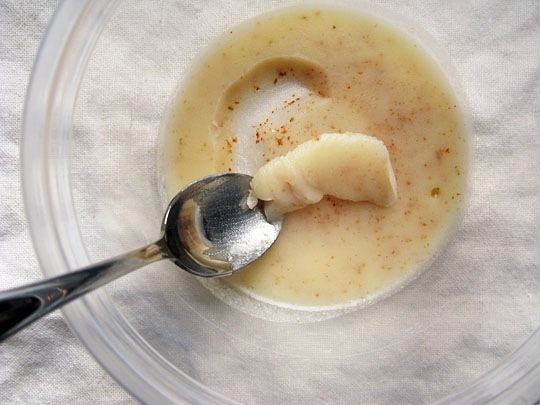
While the bacon drippings were heating up in the pan, Mother brought out a heavy plastic bag where she stored old crusts of bread, and she began to break them into crumbs. She rubbed them against the palm of her hand over a mixing bowl, until they were in fine pieces, like the crumbs for Christmas stuffing. Next, she brought the bowl of crumbs over to the frying pan and poured them in, a bit at a time, and stirred them with a wooden spoon, until they were coated in bacon drippings.

She scraped the crumbs back into the mixing bowl, and set it on the kitchen table to cool, while she put on her boots and coat. She grabbed the bowl and headed out the door into the back porch, and out to the new feeder in the orchard. Dad might not have built a fancy-looking feeder, but he had placed it at just the right height so that Mother could easily lay her bacon-coated crumbs inside.
Mother came back in the kitchen, took off her coat and boots, and we waited patiently by the window. I pushed back the curtain, and pulled up a couple of kitchen chairs so we could watch. By this time Dad had put away his tools, had come in from the garage, and was making himself a cup of coffee. He warned me not to make any sudden movements in front of the window, or I would scare the birds away, so I sat there quietly and we waited.
Less than fifteen minutes passed when we saw our first ‘customer’. We were all excited, and even Dad, who hadn’t seemed particularly interested at first, was over by the window to watch the show. The first bird at the feeder was a blue jay. He had a little blue ‘hat’ and wings, and a big round white belly. There was a blue and white pattern on his back and he had a lovely, long tail with many different shades of blue all the way to the tip. His eyes and his beak were shiny and black, and he pecked away eagerly at the crumbs in the feeder for several minutes.
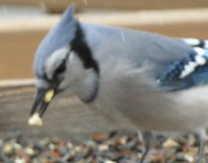
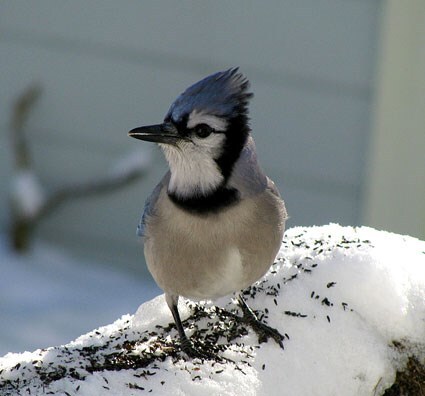
He continued to peck at the crumbs, looked around nervously, pecked again and then looked straight at us with his big black eyes as if to say ‘thank-you’, then he flew away through the orchard and over the back field, heading toward the train tracks.
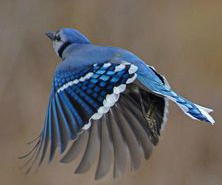
The bird feeder was a success! Dad was smiling, knowing that his efforts had been worthwhile. Mother was pleased that her very first ‘customer’ had enjoyed his meal, and hopefully would bring his friends back to dine as well, and keep in good health during the cold spell.
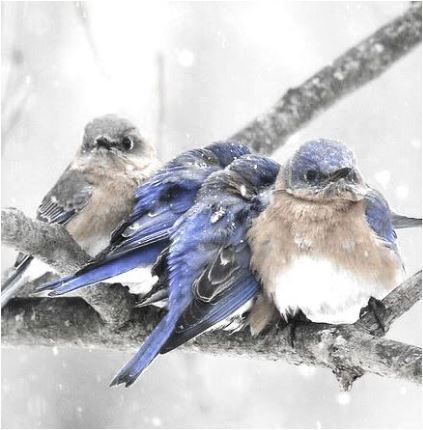
Mother’s birdfeeder would remain in the old orchard for many decades. The construction was basic, the feed was always the same – bacon grease and breadcrumbs, and over the years thousands of birds would dine at the feeder while we watched from the kitchen window. Blue Jays were always her favourites, although I saw a few handsome red Cardinals and many Black-Capped Chickadees over the years as well.
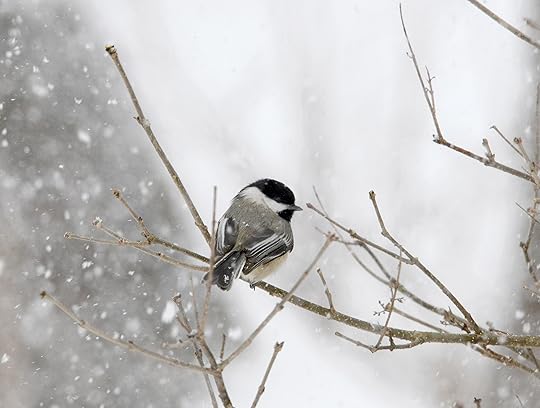
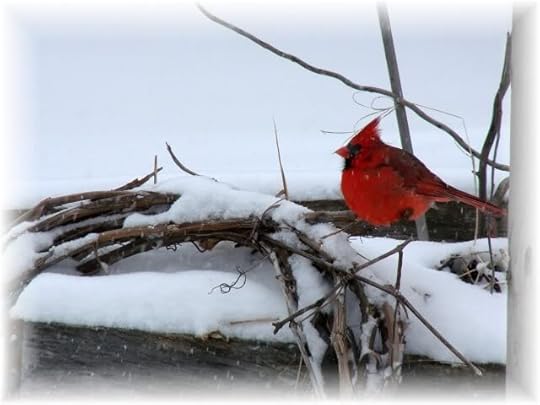
On these harsh, frigid, January days, when the winds are relentless, and the snow piles up around us, I think of our small feathered friends back on the Third Line. I wonder if the old feeder is still standing in the orchard, and if anyone thinks to put out a few crumbs and some drippings for our beautiful, hungry, winter birds. In the stark, white landscape they provided a welcome splash of colour, and their songs gave us hope through the long, silent winter.
……………………………………………………………………………………………………..
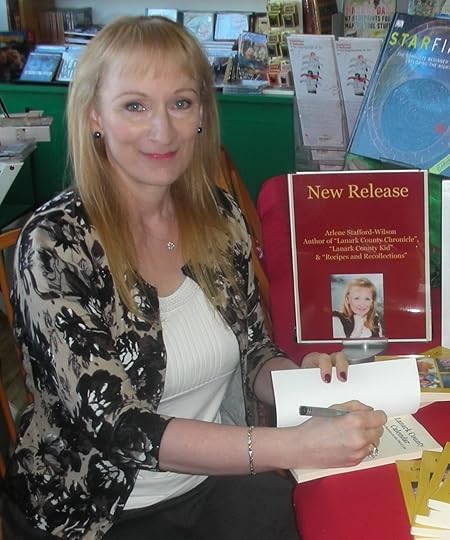
Arlene Stafford-Wilson
Member, Association of Professional GenealogistsHonorary Life Member, Lanark County Genealogical SocietyLanark County Pioneer Families Humanitarian AwardAuthor of : “Lanark County Christmas”, “Lanark County Comfort”, “Lanark County Collection”, “Lanark County Calling”, “Lanark County Classics”, “Lanark County Connections”, “Lanark County Calendar”, “Lanark County Chronicle”, “Lanark County Kid”, & “Recipes & Recollections”, & “Lanark County Kitchen”“January Feast at Mother’s Bird Feeder”
is an excerpt from “Lanark County Calendar: Four Seasons on the Third Line”
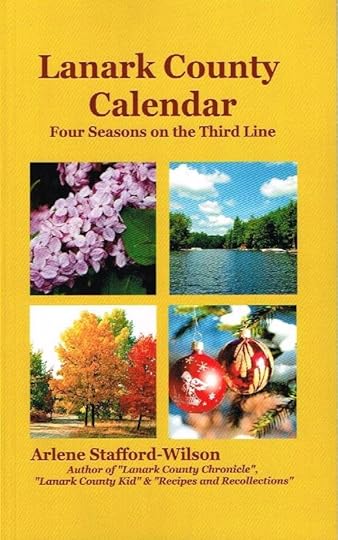
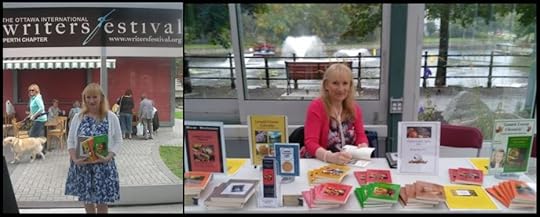
More books by author Arlene Stafford-Wilson:
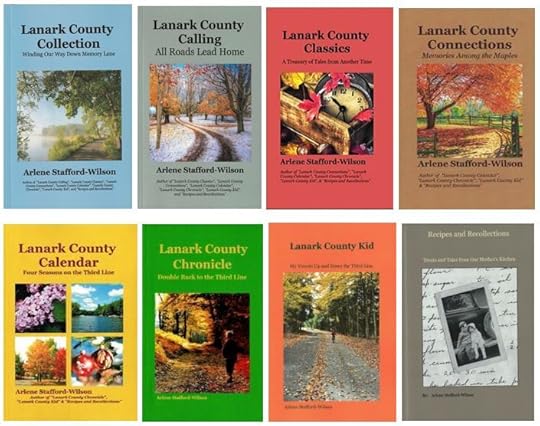
“Lanark County Kitchen: A Maple Legacy from Tree to Table”
January 15, 2024
Review – “Lanark County Kitchen”
A book review by Matthew M. Thomas, Ph.D. , distinguished North American maple syrup historian.
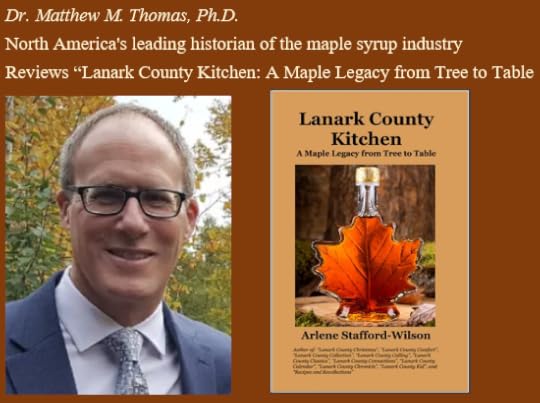
With his background in anthropology, archaeology, and geography, including a Doctorate from the Nelson Institute for Environmental Studies at the University of Wisconsin, Matthew has been researching and writing about the history of maple syrup and sugar for the past twenty years. His website https://maplesyruphistory.com/ features a vast collection of articles and information on maple syrup.
On January 10, 2024, Matthew’s website featured a review of “Lanark County Kitchen: A Maple Legacy from Tree to Table”.

.
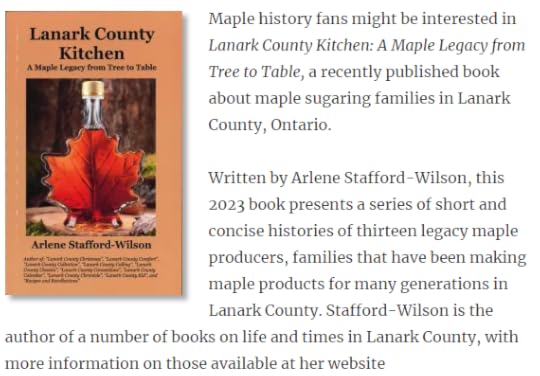


Many thanks to Dr. Matthew Thomas for his kind review of “Lanark County Kitchen: A Maple Legacy from Tree to Table”
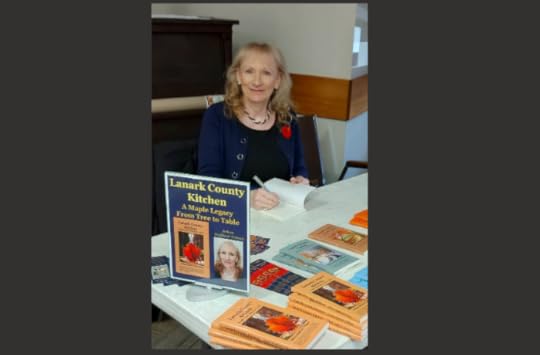
Arlene Stafford-Wilson
Honorary Life Member, Lanark County Genealogical Society
Member, Association of Professional Genealogists
Lanark County Pioneer Families Humanitarian Award
Author of : “Lanark County Kitchen”, “Lanark County Christmas”, “Lanark County Comfort”, “Lanark County Collection”, “Lanark County Calling”, “Lanark County Classics”, “Lanark County Connections”, “Lanark County Calendar”, “Lanark County Chronicle”, “Lanark County Kid”, & “Recipes & Recollections”
January 10, 2024
Mother’s Farmhouse Pancakes
Christmas had come and gone for another year, and by early January we were back in our classrooms at Glen Tay Public School. Frigid, gray mornings were spent shivering at the end of the long lane, waiting for the big orange school bus to come rattling up the Third Line.

Even though the winter solstice had passed, the days in Lanark County were still short and dark for the most part. The cold months that were still to come stretched out ahead of us like the long, heavy, trains that thundered and chugged down the tracks, back the side road, near the Fourth Line.

Winter in the country sometimes looked barren and lifeless. The soft green grass and fragrant flowers were almost forgotten, as they lay dormant under the heavy blanket of snow. The massive, frozen, white shroud seemed to conceal every trace of life that had ever existed in our yard.

Evenings after school were spent shoveling, pushing, and lifting the snow, from one pile to another. Week after week more snow fell, and it blew and drifted back into the paths that we’d made.
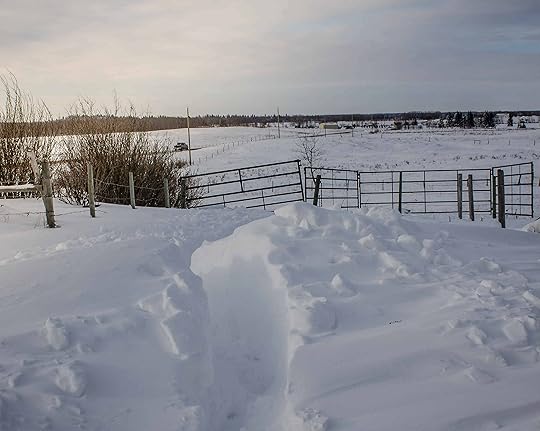
I was always cold, always shivering, cold face, cold hands, cold feet on the floors of the old house. Even with layers of tattered, wool blankets on the bed, the icy drafts snuck into my room, and the windows were coated in a heavy layer of frost. The wood stove in the kitchen eventually died out over night, and my glass of water on the bed-side table was frozen like a miniature hockey rink by morning.
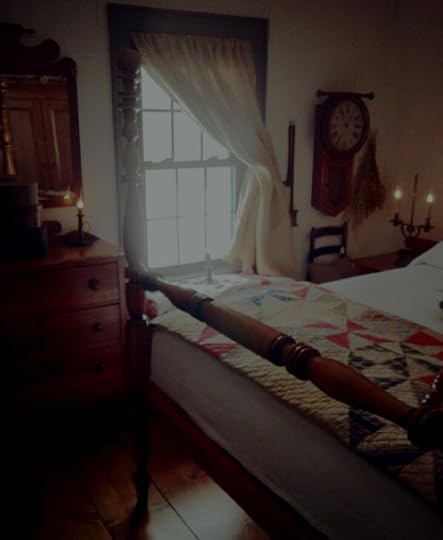
The turkey sandwiches, so delicious on Boxing Day, began to lose their luster, as the first few days of the new month found us eating the leftovers from the enormous Christmas bird. Turkey soup. Turkey pot pie. Turkey casserole. Would it ever end? Endless stacks of sliced turkey were stored in the old chest freezer for those daily turkey sandwiches, dressed with mustard, salt and pepper, staring up at me from my lunch pail at school.
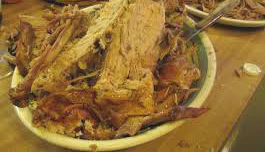
One morning that same January, before heading off to work, at Chaplin’s Dairy in Glen Tay, Dad requested, ever so politely, that we have eggs for supper that evening. Eggs were one of Dad’s favourite meals, any time of day. He liked them fried, over easy, boiled, scrambled, any way at all, and that was his request for supper. My fingers were crossed that Mother would comply and take a break from her relentless production of turkey leftovers.

What a treat it would be to have a nice, light supper after so many heavy meals, rich baked goods, and endless servings of turkey! After Dad left that morning, Mother decided that she would indeed make fried eggs and pancakes for supper, so she began to assemble her ingredients. Hopefully she had everything she needed, or one of us would be making a long, cold trek down to Cavanagh’s store in DeWitt’s Corners.
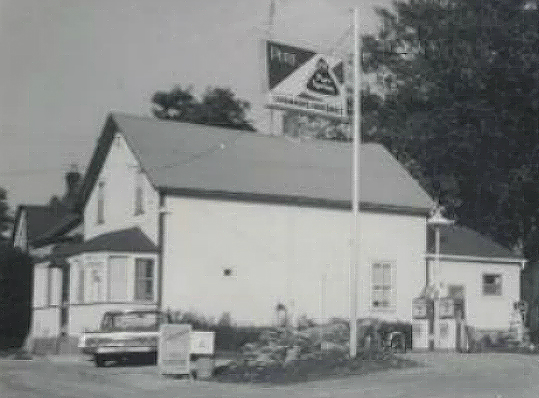
Mother began her preparations on the old kitchen table. I breathed a sigh of relief, welcoming a change from the endless turkey leftovers. On that cold winter’s evening, so long ago, when Dad returned from work, we had the very best cure for a January Turkey Hangover.
……

3 cups all purpose flour
3 Tablespoons sugar
3 teaspoons baking powder
1 ½ teaspoons baking soda
¾ teaspoon of salt
¼ teaspoon of cinnamon
3 cups buttermilk
½ cup milk
3 eggs (Mother always used large eggs)
1/3 cup melted butter
1 teaspoon vanilla
Our Mother, being a prize-winning baker at the Perth Fair, had a few good tricks for making her pancakes light and fluffy and melt-in-your-mouth delicious.
First, let your buttermilk, milk and eggs sit out for a full hour before making the pancakes. By allowing them to reach room temperature the pancakes will rise higher and fluffier.
Use real butter, don’t substitute with margarine, or the flavour will not be as good.
Make sure that your baking powder is fresh to give as much lift and height possible to the pancakes.
Use real buttermilk. If it’s not possible to use real buttermilk, you can sour some regular milk by adding a tablespoon of lemon juice or vinegar to each cup of milk. The recipe will still work, but the flavour will not be nearly as rich as using real buttermilk. We always had a quart of buttermilk in the fridge because Dad liked to have a small glass at night before bedtime. Buttermilk is low in fat and very high in protein.
What is Buttermilk?In case you don’t know, buttermilk is the fluid remaining when the fat is removed when cream is churned in to butter. When I was a kid, farmers separated the milk from the cream on the farm, and shipped cans of cream to cheese factories once or twice a week. The cream would be used to make cheese and butter. Today, cultured buttermilk is produced by adding lactic acid to pasteurized whole milk and adding a touch of salt.
Don’t forget – Mother always warned us not to stir the pancake batter too much. Over-stirring will cause the pancakes to be flat, not fluffy. Just stir ever so slightly, don’t worry about the lumps of flour, just combine the wet and dry ingredients together gently with a wooden spoon or spatula; don’t over-mix.
Method:Use a large bowl and combine your flour, sugar, baking powder, baking soda, salt and cinnamon.
In another large bowl, combine your eggs, buttermilk, milk, melted butter and vanilla.
The wet and dry ingredients should be kept separate until you are ready to make the pancakes.
Next, heat a lightly oiled frying pan at medium-high heat. To test the temperature you can add a drop of water to the center of the pan, and it should bead up and sizzle.
When the pan is ready, you can mix the wet and dry ingredients. Remember, just mix very lightly, and don’t worry about the lumps. Never over-stir. This is very important.
Scoop up the batter with a ladle and use about half a cup for each pancake. When one side is golden, flip it over with a spatula and cook the other side. Add more oil to the pan as required.
This recipe will make a dozen 5-inch pancakes.
If you have any leftover pancakes, you can let them cool, place waxed paper between them and freeze.
Top the finished pancakes with salted butter and some Lanark County Maple syrup. For a fancy look you can sift a bit of icing sugar on top.
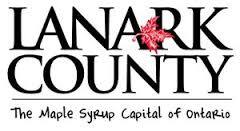
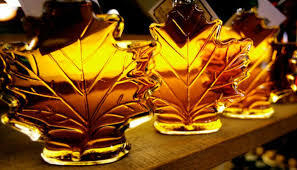
If you’re having eggs with your pancakes, like we did, fry them up in a little bacon grease for added flavour. Mother always poured her leftover bacon drippings into a small container and kept it in the fridge. Use it for frying eggs, onions, and home-fries, and make an old fashioned country-style meal.
So cure your January turkey hangover, enjoy some fluffy Buttermilk Pancakes!
…..
Note: To discover “10 Things You May Not Know About Maple Syrup”, and for a listing of the top maple syrup producers in Lanark County: 10 Things You May Not Know About Maple Syrup
…..

Arlene Stafford-Wilson
Honorary Life Member, Lanark County Genealogical SocietyMember, Association of Professional GenealogistsLanark County Pioneer Families Humanitarian AwardAuthor of : “Lanark County Christmas”, “Lanark County Comfort”, “Lanark County Collection”, “Lanark County Calling”, “Lanark County Classics”, “Lanark County Connections”, “Lanark County Calendar”, “Lanark County Chronicle”, “Lanark County Kid”, & “Recipes & Recollections”and “Lanark County Kitchen: A Maple Legacy from Tree to Table”January 4, 2024
January 6th – Irish Women’s Little Christmas
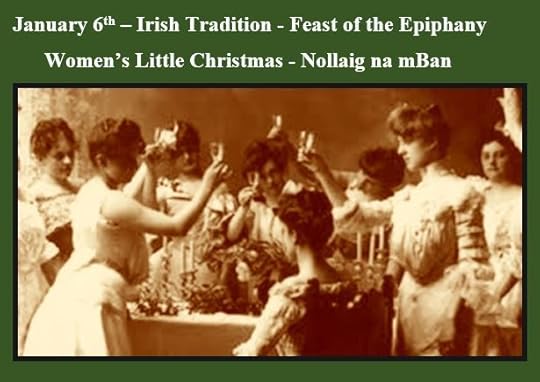
Women’s
Little Christmas
Nollaig na mBan (pronunciation Null-ug na Mon) is ‘Women’s Little Christmas’ or the Feast of the Epiphany as it is more commonly known—marking the end of the 12 Days of Christmas, a Christian feast day celebrating the the visit of the Three Kings or Wise Men to the baby Jesus in his manger in Bethlehem, with their gifts of gold, frankincense and myrrh.
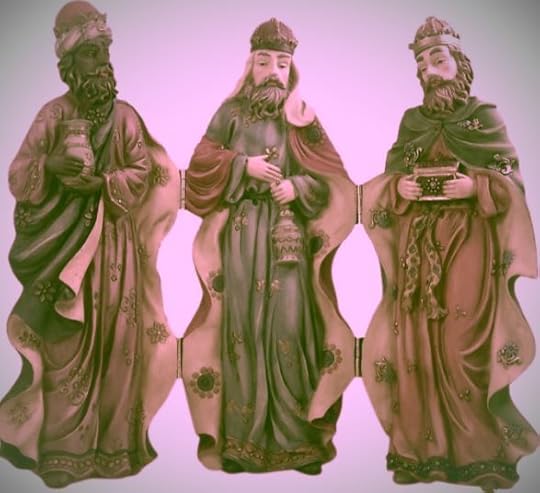
Taking Down
the Decorations
Women’s Little Christmas Eve is the day when some will add the wise men to their nativity displays. This would be the final decoration added in the home, done on January 5th, and at the end of the day on January 6th, these, and all of the other decorations would be taken down. Some Roman Catholic families chose to keep their tree up until February 2nd, according to the traditions of Candlemas, which marks the presentation of Jesus at the Temple.
The Burning
of the Holly
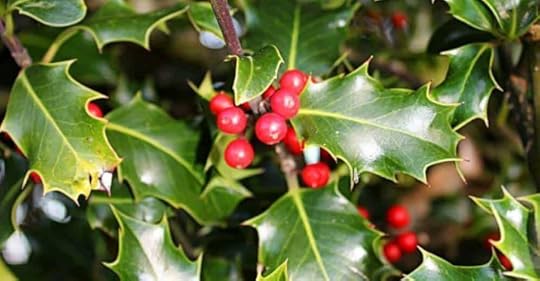
In ancient times, in more modest Irish homes, holly was the only decoration used, and so it was taken down from the mantle, and burned on January 6th for good luck. It was symbolic to leave the holly up until Women’s Little Christmas.
Holly was thought to have important spiritual attributes, and the Druids believed it could guard against dark witchcraft and evil spirits. The Irish believed that its spikes could capture evil spirits and prevent them from entering a house. Holly placed around the home was thought to be a safe haven for the little people, who traditionally guarded the house from more sinister forces.
It was a tradition if holly was the first evergreen plant to be brought into the house at Christmastime, then the man would have the upper hand and rule the roost for the coming year. For that reason, women usually instructed that the ivy be collected first, then the holly. The timing of taking down the holly was very important. Once brought inside it must not be discarded or taken down until after 6th of January. Throwing out a symbol of good fortune too soon could mean that you were looking for trouble.
Visiting with Friends
and Neighbours
Women’s Little Christmas, on January 6th each year, was the day that women rested and relaxed after a busy season of cooking and festivities. In rural and small-town Catholic Ireland, women gathered in each other’s homes, or down at the local pub, for a few hours of fun, while men looked after the home and the children. As all were seated, a pact was made, to leave the worries and cares of the old year, outside the door.
Some women stayed in their neighbourhood, and did rounds of visiting in the afternoon. Fruit loaf and tea, or a shot of something stronger, served at someone’s house, and was the day that women did something for themselves, and had a rest after all of their Christmas work.
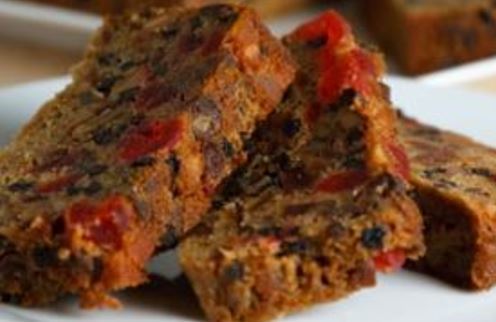
….And what would a Women’s Little Christmas be without a nice warm Irish Toddy to finish the day?
Irish Toddy Recipe
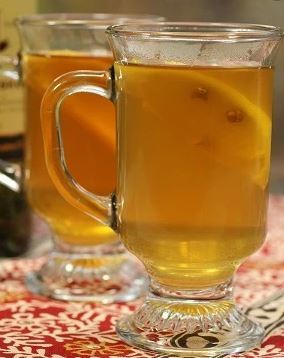
Irish Toddy
1 ½ teaspoons brown sugar
Boiling water
1 measure of Irish Whiskey (Bushmills or Jameson)
3 cloves
1 slice or wedge of lemon
You may use any whiskey you desire, or for an authentic Irish toddy, use Bushmills or Jameson Irish Whiskey
Add sugar, and dissolve in a splash of the hot water.
Add the whiskey, cloves (if desired) a slice of lemon, and fill up with boiling water.
It is customary to give a New Year’s toast on Women’s Little Christmas, with an Irish blessing:

–

Arlene Stafford-Wilson
Honorary Life Member, Lanark County Genealogical Society
Member, Association of Professional Genealogists
Lanark County Pioneer Families Humanitarian Award
Author of : “Lanark County Christmas”, “Lanark County Comfort”, “Lanark County Collection”, “Lanark County Calling”, “Lanark County Classics”, “Lanark County Connections”, “Lanark County Calendar”, “Lanark County Chronicle”, “Lanark County Kid”, & “Recipes & Recollections”
and “Lanark County Kitchen: A Maple Legacy from Tree to Table”
January 3, 2024
Lanark County Quilting Legends – of the 1950s, 60s and 70s
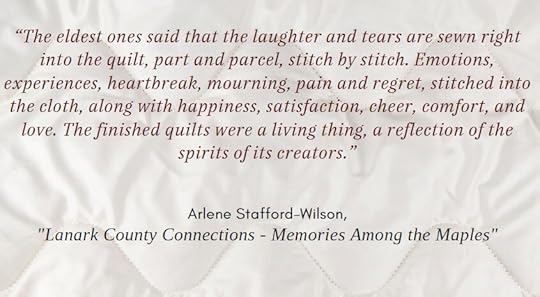
Almost every family had one – a quilter; someone who could take random bits of cloth, even scraps or rags, and turn them into a work of art. They were the creative ones; usually the quiet ones, sitting off in a corner, away from the crowds, working on their quilting blocks, embellishing their squares of cloth with embroidery, and intricate stitchery. They were the serious ones, labouring with precision, ensuring that their stitches were evenly spaced, even in places hidden deep within the seams of the cloth.
These quilters were the unsung heroes of home crafting. Blessed with nimble fingers, tireless hands, and meticulous sight, they turned the family’s cast-off clothing and abandoned fabrics into beautifully designed bedcovers; fit for the coldest Eastern Ontario winters. Often young, inexperienced hands worked alongside older, farm-weathered hands, at community quilting bees. The older ones were the masters, the coaches, and the instructors, guiding the young ones on the finer points of their art.

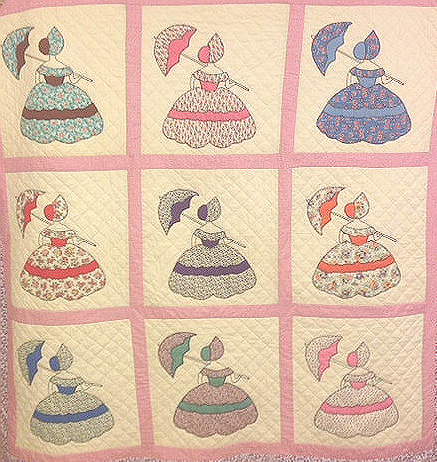

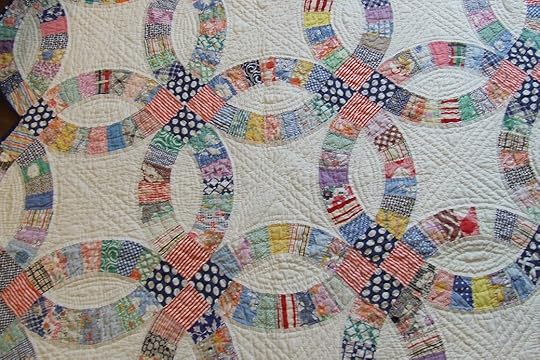
Many of these artisans were sociable, and organized quilting bees, welcoming all of the ladies in the neighbourhood. They assembled quilting frames, and set up sturdy, wooden chairs all around, inviting the experienced and the not-so-experienced, to join the circle.

There were lively conversations along with occasional laughter and story-telling, mixed in with the stitching. The quilting bees always ended on a high note – with hot tea poured lovingly into delicate china cups, served alongside decadent homemade cookies and squares.

A few quilted on their own, but many were members of local churches, community organizations, or Womens’ Institutes.
…………………………………………………………….
Eleanor Conboy’s Quilts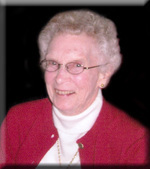 (Eleanor was the daughter of George Garrett and Edith Armstrong)
(Eleanor was the daughter of George Garrett and Edith Armstrong)Eleanor Conboy (1922-2015) was an avid quilter, and good friend to my mother. The Conboy family farm was not far from the Stafford home on the Third Line of Bathurst (Tay Valley Township) Eleanor Conboy and Audry Stafford often worked at the quilting ‘bees’ together, at neighbour Lottie (Charlotte Keays Jordan) Jordan’s house.
Many thanks to Trina McMillan Conboy for sharing the photos below, of some of Eleanor’s beautiful quilts!

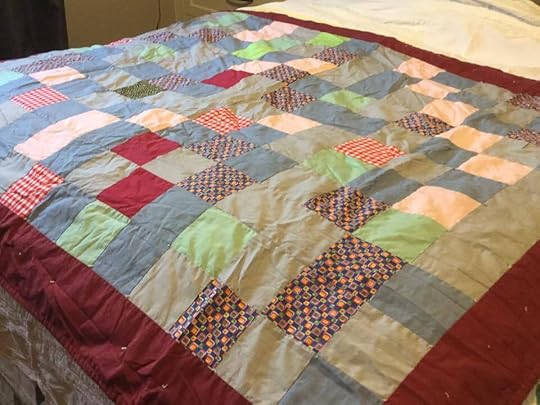
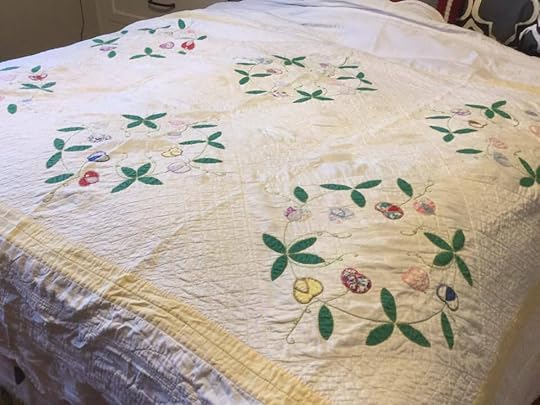
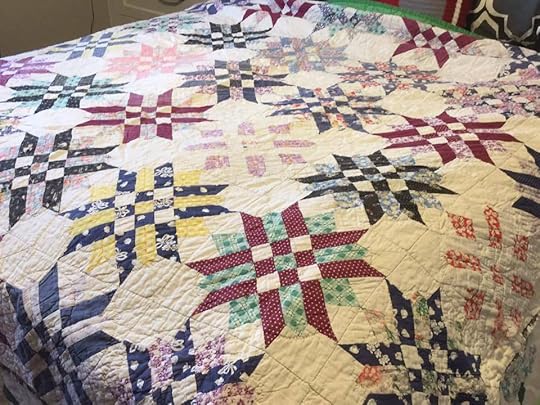
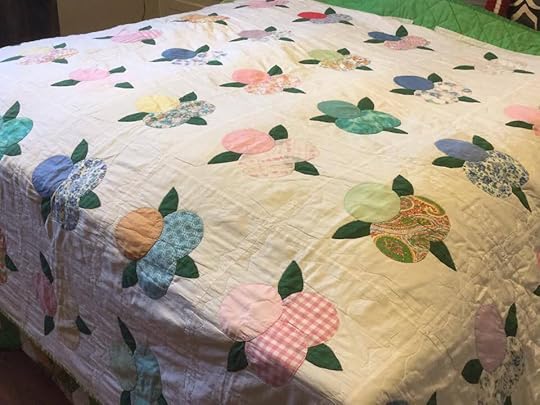
………………………………………………………………………………………………………………………………………………….
200th Anniversary Quilt- by the Lanark County Quilters GuildThis quilt was designed and produced by the Lanark County Quilters Guild to commemorate the 200th Anniversary of the pioneer settlement, and features a map of Lanark County.

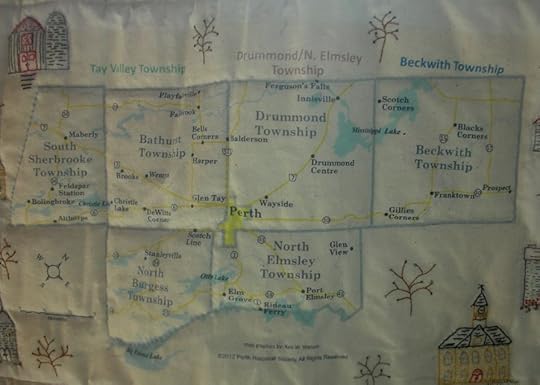
One of the most beautiful quilts in Lanark County, was crafted by the ladies of Ferguson Falls, and features many of the local names on each square. Known as ‘The Shamrock Quilt’, it was donated to the Lanark Museum, and may be seen there, one of their treasured artifacts.

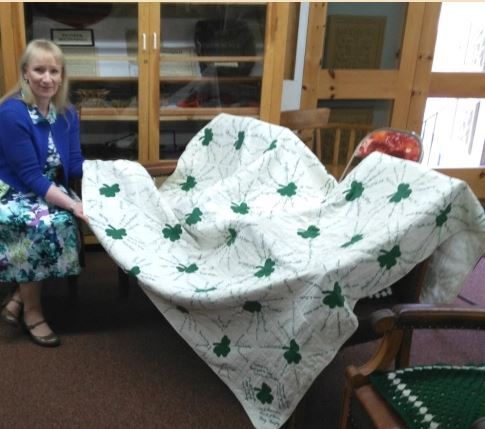
Balderson Women’s Institute
Bethel Women’s Institute
Calvin United Church – Calvinettes, and U.C.W
Drummond Centre Women’s Institute
Elphin community quilters
Flower Station community quilters
Glad Tidings Tabernacle Church, Ladies group, Perth, ON
Harper Women’s Institute
Hopetown community quilters
Innisville – St. John’s Women’s Association
Lanark – Catholic Women’s League
Maberly United Church W.A.
McMartin House, Perth, ON
St. John’s Church Perth – Catholic Women’s League, Perth, ON
Port Elmsley Women’s Institute
Rideau Ferry United Church Women’s Group
Salvation Army Church, Perth, ON
St. Andrew’s Presbyterian Church Women’s Missionary Society, Perth, ON
St. James Anglican Church, Perth, ON
St. Paul’s United Church, Ladies group, Perth, ON
Watson’s Corners U.C.W.
……………………………………………………………………………………..
The highlight of the year for many in farm country, was to enter quilts, sewing, needlepoint and other handy-work into the local fairs with the hopes of winning a first prize, second prize or third prize ribbon.

Many of us who lived in rural areas looked forward each year to the local agricultural fairs. Our mother, Audry Stafford judged the quilts at area fairs, and those as far away as Madoc and Tweed.


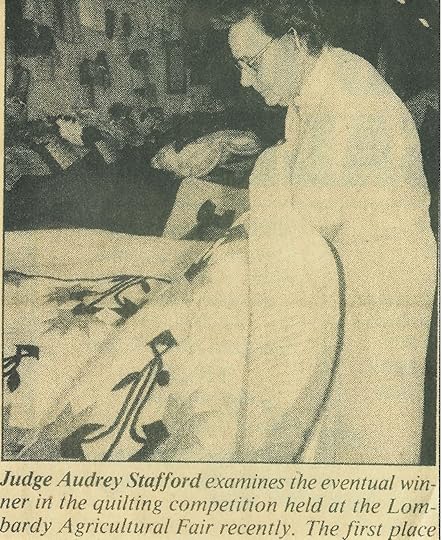
(missing text – First Place awarded to Gladys Haughian)
Whether quilts were entered in the local Fairs, raffled as church fundraisers, or created to keep family members warm on those cold Lanark County winter nights, – they each had their own unique beauty.
Some area quilters were known for their meticulous stitching, their creative designs, or how quickly they could complete their work.
Some quilters were so skilled that they even made the headlines of the local newspapers.
……………………………………………………………………………………………………………………………………………
The Port Elmsley Womens InstituteCompletes Quilt at One Sitting ! ! !……………………………………………………………………………………….
Do you remember some of Lanark County’s Quilters of the 1950s, 60s and 70s?Mrs. Ralph Affleck
Mrs. Alexander
Mrs. Elsie Anderson
Mrs. Ralph Barrie
Mrs. E. Benedict
Miss Jean Blair
Mrs. Bothwell
Mrs. Boyce
Mrs. F.J. Byrne
Mrs. Mildred Briggs
Isobel Cameron
Lillian Cameron
Marguerite Cameron
Mrs. Stewart Cameron
Mrs. Walter Cameron
Mrs. Joseph Chamney
Mrs. Charlton
Mrs. R. Charlton
Mrs. Churchill
Eleanor Conboy
Mrs. Conlin
Mrs. Cooper
Mrs. Charles Crampton
Mrs. George Crampton
Mrs. Clarke Devlin
Mrs. Cecil Dobbie
Mary Alice Donaldson
Mrs. Hilda Donnelly
Mrs. M.J. Donohoe
Mrs. Barbara Dowdall
Mrs. Betty Dowdall
Mrs. H. Duby
Mrs. Clarence Ennis
Mrs. H. Ferguson
Mrs. Dave Foster
Isobel Foster
Marlene Foster
Mrs. B. Fournier
Heather Fournier
Mrs. M.J. Furlong
Maria Fyfe
Miss Mae Gallinger
Mrs. Gamble
Mrs. Clifford Gardiner
Mrs. Lillian Gardiner
Mrs. Oliver Gardiner
Mrs. Thomas Gardiner
Mrs. Adam Geddes
Mrs. Aldon Gray
Mrs. Beverly Hall
Mrs. Earl Hallaren
Mrs. Charles Hermer
Mrs. George Ireton
Mrs. A. Ireton
Mrs. Harry Ireton
Joan Irvine
Mrs. James
Charlotte ‘Lottie’ Keays Jordan
Marion Jordan
Mary Jordan
Mrs. Edward Joynt
Mrs. Kennedy
Mrs. W.P. Kilfoyle
Mrs. Keith Knapp
Mrs. James King
Mrs. Violet Kirkham
Ethel Korry
Mrs. John Larmon
Mrs. Manion
Mrs. C. Matheson
Eleanor McInnis
Mrs. Alex McIntyre
Mrs. McPhee
Mrs. Charles Miller
Edith Miller
Mrs. Ernest Miller
Mrs. Forrest Miller
Mary Miller
May Miller
Mrs. Robert Moodie
Mrs. Eleanor Munroe
Miss Ursula Murphy
Mabel Palmer
Mrs. John Pennett
Mrs. Thomas Phelan
Mrs. Lester Polk
Mary Popplewell
Mrs. Ed Rathwell
Mrs. John Reid
Christine Rice
Florence Rice
Miss Jean Riddell
Mrs. Norman Richardson
Jean Scott
Dorothy Scragg
Eleanor Senkler
Mrs. H. Shaw
Mrs. A.M. Sheppard
Miss Elspeth Smith
Mrs. Somerville
Miss Spence
Audry Stafford
Mrs. Frank Stead
Mrs. Harold Stead
Mary Stewart
Mrs. Stokes
Mrs. E. Thompson
Madge Thompson
Bertha Toutant
Mrs. John Vanden Bosch
Mrs. George Wales
Mrs. Mabel Walroth
Mrs. H. Warwick
Mrs. Sadie Watson
Mrs. Allan Weidenmaier
Mrs. Fred Weidenmaier
Mrs. W.G. Weir
Mrs. Wilfred Wesley
Alice White
Mrs. J. White
Mrs. Roy White
Mrs. Murray Wilson
…………………………………………………………
…………………………………………………………………………………………………………………………..
15 Characteristicsof an outstanding Quilter:They possess the patience and commitment to complete a long-term project such as a quiltThey have the skill and precision to produce work with fine craftsmanshipThey have an artistic eye for good designThey have tremendous self discipline to produce consistent stitching throughout the pieceThey have a natural gift of creativity and originalityThey have a rare ability to see connections in patterns, and to draw ideas from many sourcesThey possess a high level of esthetic skills in order to situate patterns to set them off to their advantageThey have the ability to focus on solutions, not on regrets. When they make mistakes, they learn from experienceThey experiment with open minds in order to improveThey meaningfully communicate with others in the quilting circle to share ideasThey create designs that have the power to withstand timeTheir works are easily distinguished from others of their own timeThey have the ability to portray light, perspective, color and spaceThey teach others and pass down their knowledgeThey inspire others to be the best they can be!These quilting legends of Lanark County passed down their knowledge, and left their legacy in the form of the beautiful quilts that they produced. They were the gifted artisans of their time, and will be remembered for their delicate stitching and colourful designs, works of art that will be handed down through families, for generations to come.
***If you remember a Lanark County quilter, or a quilting organization, (1950s-70s) that has not been mentioned in this article, please send their name in the ‘comments’ box below, and they will be added.
To view additional squares of The Shamrock Quilt, photographed at the Lanark Museum:
The Shamrock Quilt at the Lanark Museum
To learn more about the 200th Anniversary Quilt produced by the Lanark County Quilters Guild in 2016 and the celebration in Tay Valley Township:
200th Anniversary Quilt – 2016
To discover more about quilting in the 1950s, 60s and 70s in Lanark County, read “The Quilting Queens of Lanark County”, from “Lanark County Connections – Memories Among the Maples” ISBN 978-0-9877026-47
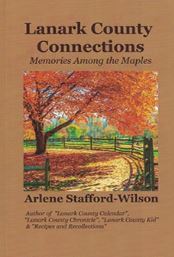
Arlene Stafford-Wilson
Honorary Life Member, Lanark County Genealogical SocietyMember, Association of Professional GenealogistsLanark County Pioneer Families Humanitarian Award 2023Author of : “Lanark County Kitchen”, “Lanark County Christmas”, “Lanark County Comfort”, “Lanark County Collection”, “Lanark County Calling”, “Lanark County Classics”, “Lanark County Connections”, “Lanark County Calendar”, “Lanark County Chronicle”, “Lanark County Kid”, & “Recipes & Recollections”
http://www.staffordwilson.comJanuary 2, 2024
Lanark County Ice Storm 1998

5 Days of Freezing Rain…
On January 4, 1998, the freezing rain began, lasting five days, and Eastern Ontario and Southern Quebec were hit with over 100 millimetres of ice pellets. This storm became one of the worst natural disasters in Canadian history.
The heavy layers of ice coated tree branches which fell on hydro-electric lines, and soon almost 4 million people were without power, some for days, and many for several weeks.
Maple syrup bushes, some that had been part of family enterprises for generations suffered devastating damage as young trees toppled from the weight of the ice, and branches on older established trees snapped and fell to the ground.
Over half a million people, including seniors in long-term care, were forced from their homes into make-shift local shelters operating on emergency power backup. In some remote areas of Eastern Ontario, the O.P.P. went door to door, providing transportation to shelters making sure that none of the elderly were left to fend for themselves in the cold and the dark.
A state of emergency was declared in Ontario and Quebec, calling on the Canadian Armed Forces to assist in clearing the roads of tree branches and debris, aid in moving stuck vehicles, helping stranded families and assisting in the restoration of power and providing basic necessities.
Power Outages
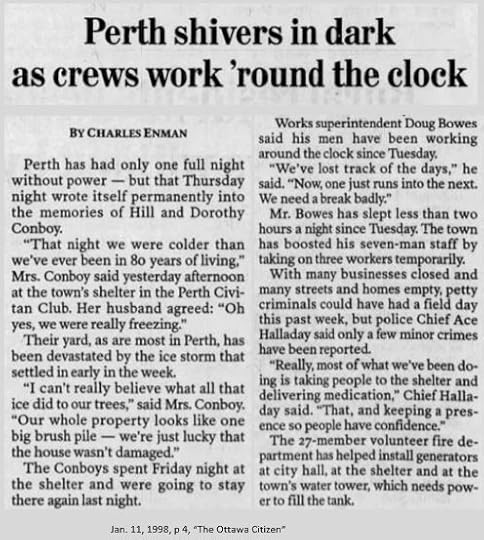
“I can’t really believe what all that ice did to our trees”, said Mrs. Conboy, “Our whole property looks like one big brush pile....”
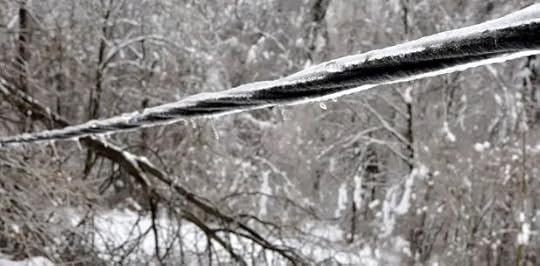
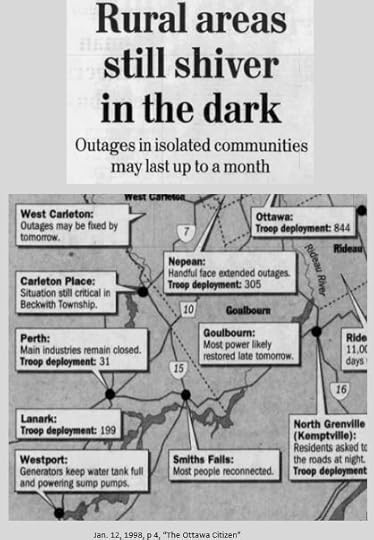
“Many people living outside of Perth were not able to return to their homes, and are staying at the Civitan Hall”
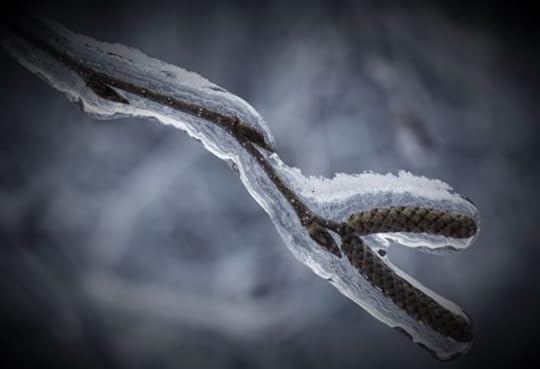
People Flocked to Shelters

Layers of ice coated the power lines
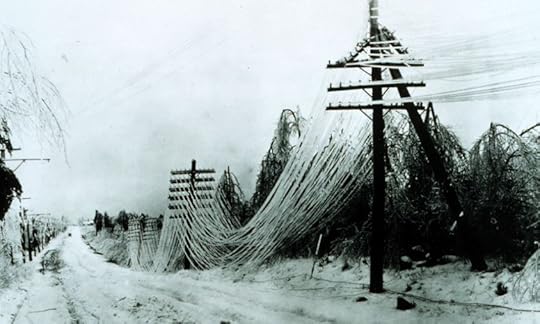
“Days?, Weeks? How Long? Even the Chairman of Ontario Hydro didn’t know.”
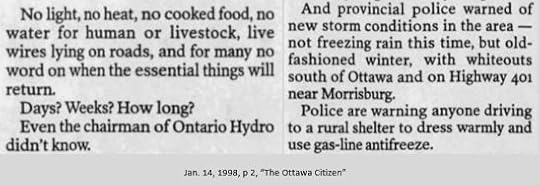
“Lanark reeve, Larry McDermott closed the village liquor store, saying it’s too dangerous a time to let people drink.”
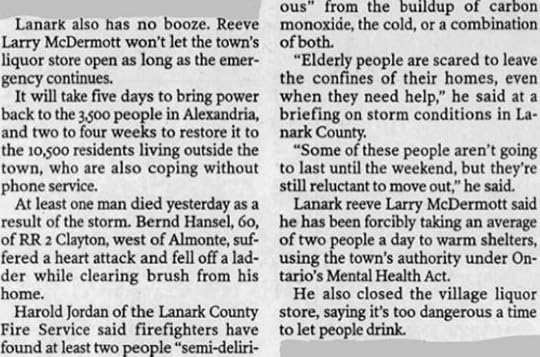 Jan. 14, 1998, p. 2 “The Ottawa Citizen”
Jan. 14, 1998, p. 2 “The Ottawa Citizen”“Harold Jordan of the Lanark County Fire Service said firefighters have found at least two people ‘semi-delirious’…”
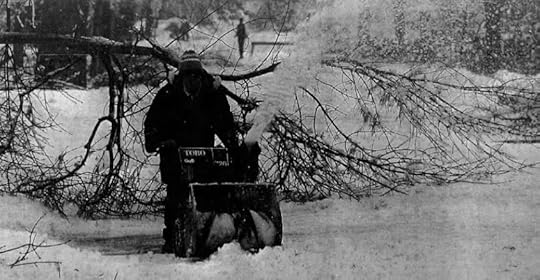
“…severe ice storm that has left millions of Canadians without electrical power.”

Branches snapped and trees fell
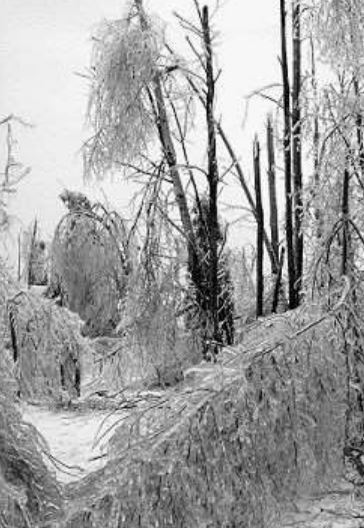

“Mrs. Congreves lives on a remote country road in Lanark Highlands Township with her husband and three young children.”

(story continued below)
“Their home was warmed by a wood stove, which also served to heat their food and boil water.”
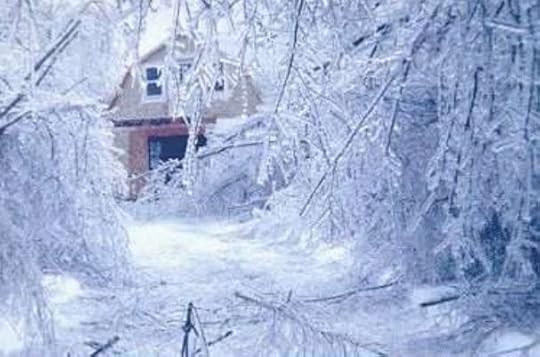
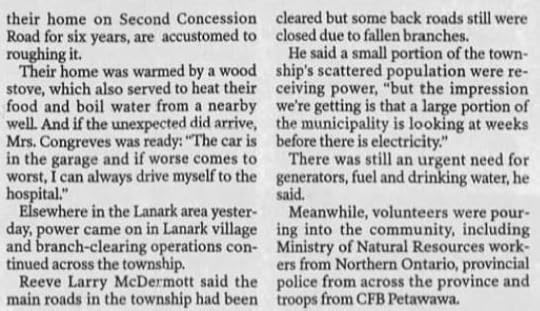 Jan. 16, 1998, p. 41 “The Ottawa Citizen”
Jan. 16, 1998, p. 41 “The Ottawa Citizen”“The main roads were clear but some back roads were still closed due to fallen branches.”
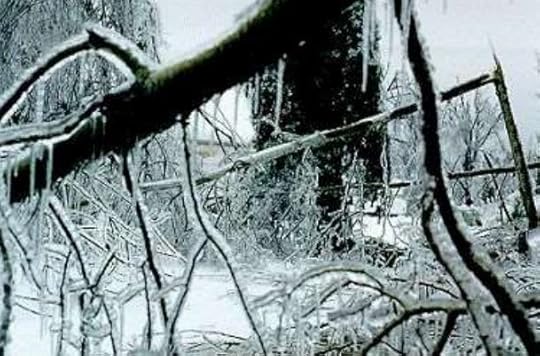

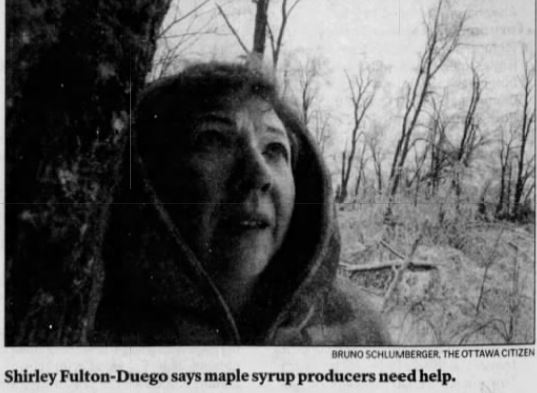
“About 90% of Eastern Ontario’s maple trees have been damaged…”
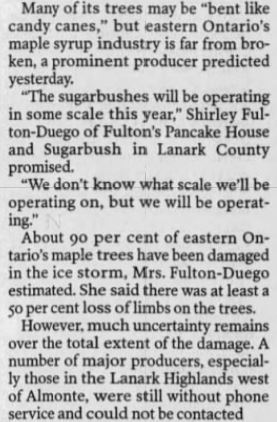
“Many trees were bent like candy-canes.”
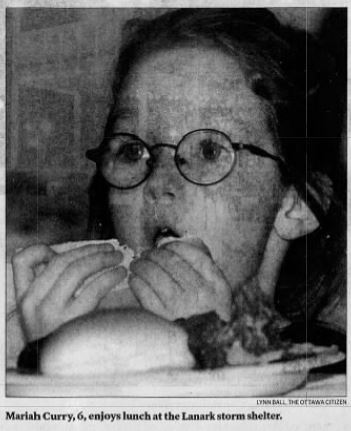

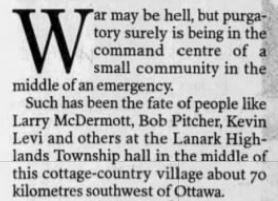
“Last night was the first night I got more than four hours’ sleep.”

“Fire Chief, Dave Smith, performed these same tasks in the Tatlock, French Line and County Road 511 area.”
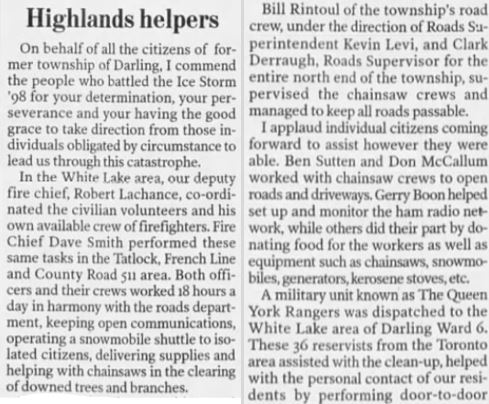
“This courageous group of young men and women deserves our gratitude for the excellent job done.”
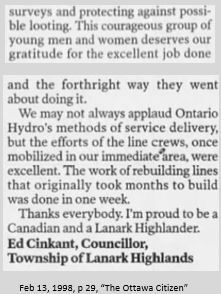
…And then came the floods
in the spring of 1998
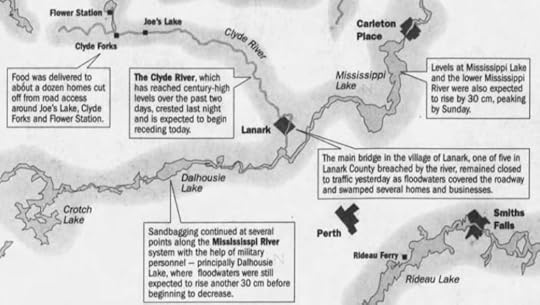 April 3 1998 p. 40, “The Ottawa Citizen”
April 3 1998 p. 40, “The Ottawa Citizen”“On Wednesday it was running under the bridge in the village of Lanark, but by the next morning the bridge was flooded.”
 April 3, 1998 p. 40, “The Ottawa Citizen”
April 3, 1998 p. 40, “The Ottawa Citizen”
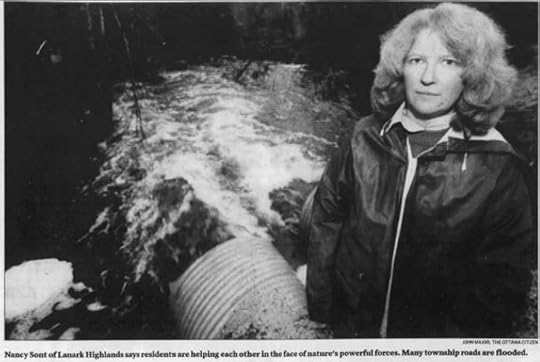 April 3, 1998, p. 41, “The Ottawa Citizen”
April 3, 1998, p. 41, “The Ottawa Citizen”“Flower Station, Joe’s Lake, The French Line, Dateman’s Bridge and Bow Lake have been cut off by the water flowing over the bridges.”
 April 3, 1998, p. 41, “The Ottawa Citizen”
April 3, 1998, p. 41, “The Ottawa Citizen”“She got out on Wednesday, before the water rose around the walls of her house.”

“For three days, raging flood waters turned the residents of Flower Station into stranded castaways.”

 April 5, 1998, p. 18, “The Ottawa Citizen”
April 5, 1998, p. 18, “The Ottawa Citizen”“Rugs were floating, a rocking chair bobbed and the refrigerator heaved as the main floor of the two-storey house became part of the Mississippi.”

Flood Map April 5 1998
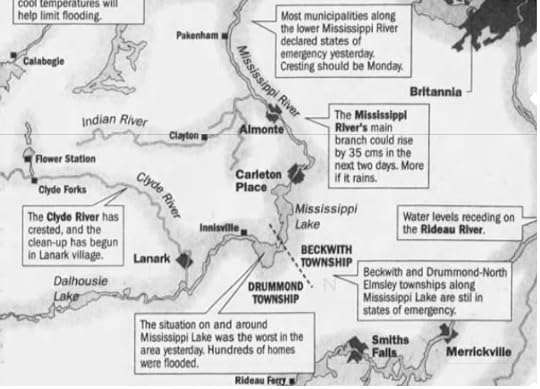 April 5, 1998, p. 18, “The Ottawa Citizen”
April 5, 1998, p. 18, “The Ottawa Citizen”“Dave Willoughby paddles a boat over his front yard…”
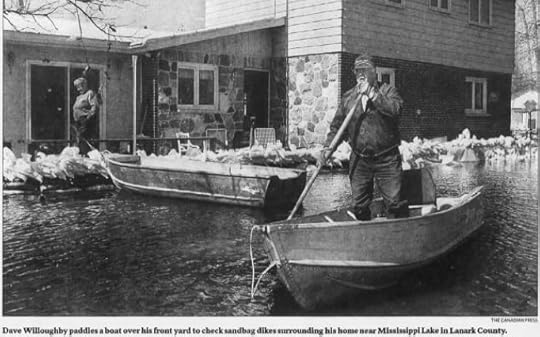
Barb and John Baker
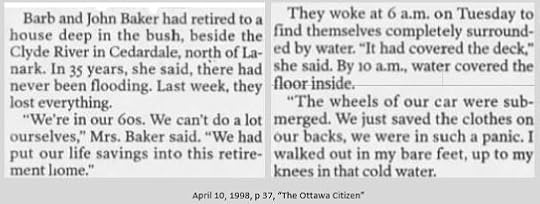
The Dean Family

Joe Paul
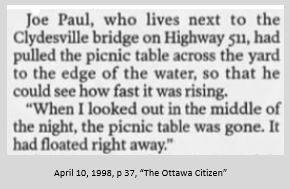
Shawn and Preston Laming
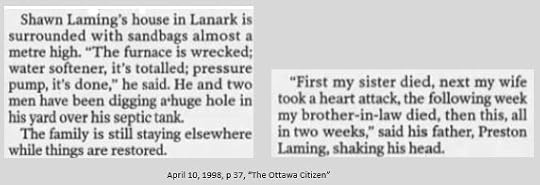
Debbie Caldwell
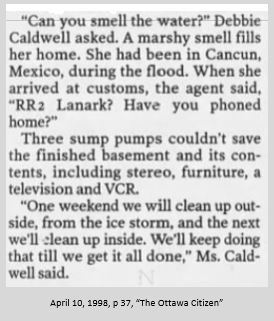
Restoration

Recovery was slow but steady, and gradually the damages caused from the ice storm and the floods that followed later that spring were restored. Many years passed before Lanark County’s maple trees fully recovered and operations in sugar bush businesses eventually returned to normal levels of production.
Stories of the ice storm have been told and re-told, and many of us have vivid memories of those days when ice coated everything outdoors, when our power was out, and in the coldest month of the year there was no heat nor light.
Many of us will also remember the special moments during those darkest times, when neighbours helped neighbours, and strangers became friends.
The days and nights of the ice storm and the spring floods of 1998 were some of the worst times that any of us had ever experienced, but we could also say that these challenges of a lifetime brought out the best in us all.

Arlene Stafford-Wilson
Honorary Life Member, Lanark County Genealogical Society
Member, Association of Professional Genealogists
Lanark County Pioneer Families Humanitarian Award
Author of : “Lanark County Christmas”, “Lanark County Comfort”, “Lanark County Collection”, “Lanark County Calling”, “Lanark County Classics”, “Lanark County Connections”, “Lanark County Calendar”, “Lanark County Chronicle”, “Lanark County Kid”, & “Recipes & Recollections”
and “Lanark County Kitchen: A Maple Legacy from Tree to Table”
(includes a history of the legacy maple producers and how their businesses were affected by the Ice Storm of 1998)
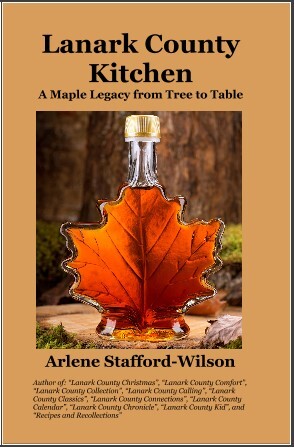
December 30, 2023
Lanark County Scottish New Year – Hogmanay
Among the earliest settlers to Lanark County were Scots who came from Glasgow and Lanarkshire, after the Napoleonic war. These immigrants settled mostly in the townships of Dalhousie, Lanark, North Sherbrooke and Ramsay. In 1820, approximately 400 families arrived in Lanark County, bringing their skills in cotton weaving, carpentry, blacksmithing and shoe-making. Many of these Scots also brought their traditions from the old country, and one of their most beloved was their New Year’s known as Hogmanay.
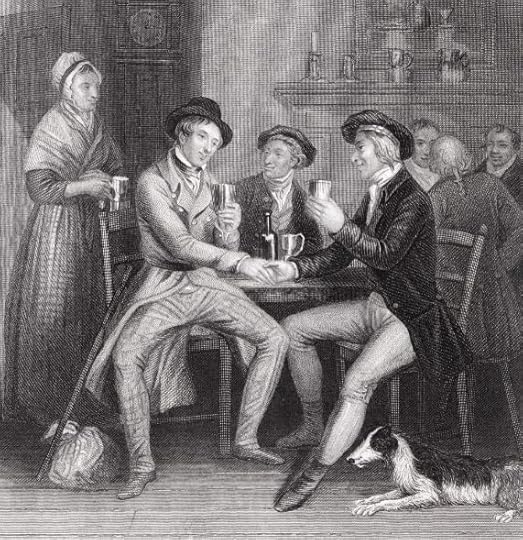
Many of these Hogmanay traditions were brought to Scotland by the Vikings in the early 8th and 9th centuries. In some parts of Scotland, like Shetland, the Viking influence remains strong, and New Year is still called ‘Yules’, derived from the Scandinavian word for the midwinter festival of Yule.
Christmas was not celebrated as a festival and was banned in Scotland for around 400 years, from the end of the 17th century to the 1950s. This was because of the Protestant Reformation movement, when it was believed that Christmas was a Catholic feast, and should be banned.
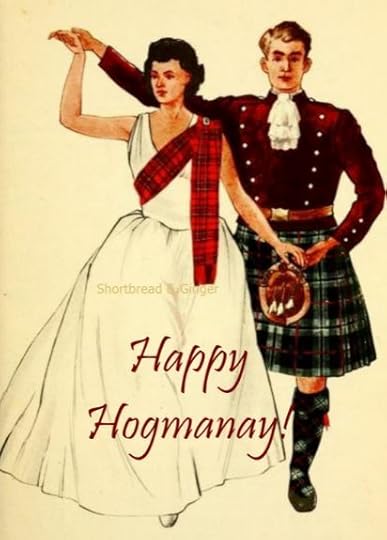
Hogmanay Traditions
It was customary to clean the house, and take out the ashes from the fire. It was also a requirement to clear all your debts before “the bells” sound midnight, the underlying belief was to clear out the remains of the old year, and have a clean slate to welcome in a young New Year.
First Footing
First Footing refers to the first person to cross your threshold after midnight on New Year’s Eve. They must be dark-haired, which is an ancient tradition going back to the days of the Viking invasions, when a fair-haired person could mean trouble for your household.
They must be bearing gifts, and specifically – a half-bottle of scotch whisky, a generous piece of black bun, a few pieces of coal. The whisky and black bun is to ensure that the home has food and drink in the coming year, and the coal is symbolic that the home will be warm in the year ahead.
Once the first footer crosses the threshold (and they can be turned away if they are light-haired), they are led through the entire home. When the tour is finished they place the coal on the fire, offer whiskey to the family, and the black bun is sliced and shared. Next, they kiss every female in the home, and wish them all the best in the new year.
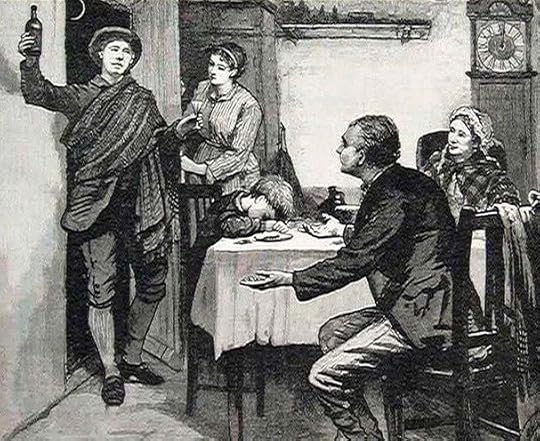
“The first-footer should be dark complexioned,
and their name begins with straight, not curvy letters.“

First Footing Rules
The first footer brings all the luck, good or bad, for the year ahead.
They should be male and dark-haired.
They may not be doctors, members of the clergy or grave-diggers, and must not have eyebrows that meet in the middle.
They should bring whiskey, coal, and black bun.
A first footer may claim a kiss from every woman present.
If your First Footer doesn’t meet all the requirements, then the household is heading for an unlucky year.

A toast is made by the First-Footer before he leaves – ” A good new year to all and many may you see”
Torchlight Parade
Fire also plays a special role in Hogmanay customs, and originates in the pagan traditions of the pre-Christian Celts. In modern times, the annual Torchlight Procession in Edinburgh continues with thousands marching through the city center carrying blazing torches.
Scottish Black Bun

Black Bun recipe:
Pastry Case
3 c flour
1/2 tsp baking powder
6 Tbsp lard
6 Tbsp butter
1 pinch salt
Cold water
Filling
2 ¾ c seedless raisins
2 Tbsp brandy
1 Tbsp milk
2 ¾ c currants
1/3 c chopped almonds
1 pinch black pepper
¼ c mixed peel
1 ½ c flour
1/3 c brown sugar
1 tsp allspice
1/2 tsp ground ginger
1/2 tsp ground cinnamon
1/2 tsp baking powder
1 large egg beaten
Method
Grease an 8-inch loaf tin. Blend the lard and butter into the flour and salt and mix in cold water to make a stiff dough. This will be used to line the tin. Roll out the pastry and slice into six pieces to fit the bottom, top and all four sides of the tin. Press into the tin, pressing the overlapped sections to seal.
Mix the raisins, currants, almonds, peel and sugar together. Sift in the flour, add the spices and baking powder, then mix together with the brandy and most of the egg. Add enough milk to moisten.
Place the filling into the lined tin and top with the pastry lid, sealing the edges. Lightly score the surface with a fork.
Brush the top with milk to create a glaze.
Bake in a pre-heated oven at 325F 2-3 hours. Test with a skewer which should come out clean; if not, continue baking.
Cool in the tin and then on a wire rack.
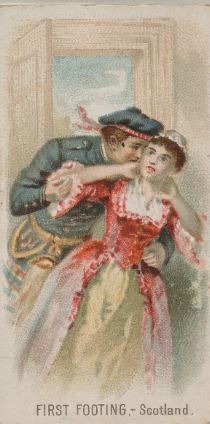
A First-Footer kisses every woman in the household
Auld Lang Syne
Immediately after midnight it is traditional to sing Robert Burns‘ “Auld Lang Syne”. Burns published his version of this traditional New Year’s song in 1788, although it is said the original was written 80 years before that.
To sing ‘Auld Lang Syne’ the traditional Scottish way, a circle is formed and hands are joined with the person on either side of you. At the beginning of the last verse, everyone crosses their arms across their chest, so the right hand reaches out to the neighbour. When the song ends, everyone rushes to the middle, still holding hands.
“Should auld acquaintance be forgot and never brought to mind?
Should auld acquaintance be forgot and auld lang syne
For auld lang syne, my dear, for auld lang syne,
We’ll take a cup o kindness yet, for auld lang syne.”
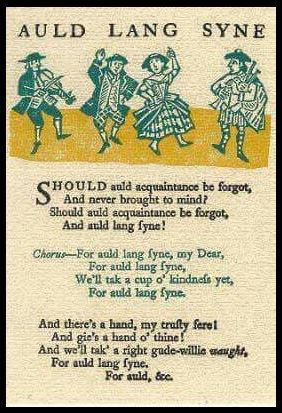
New Year’s Morning
Saining the HouseThere is a Scottish highland custom of saining (blessing) the house and and the livestock, and is still practised today, mostly in rural areas. The ritual involves the drinking of water believed to be magic which must be sourced from a river ford that’s said to be crossed by both the living and the dead. Next is the burning of juniper branches, enough to fill the house with smoke, and is believed to cleanse the house and drive away evil spirits.
After these two rituals are completed, the windows and doors are opened to let in fresh, New Year air, and a wee nip of whisky is taken before indulging in a hearty Scottish breakfast.
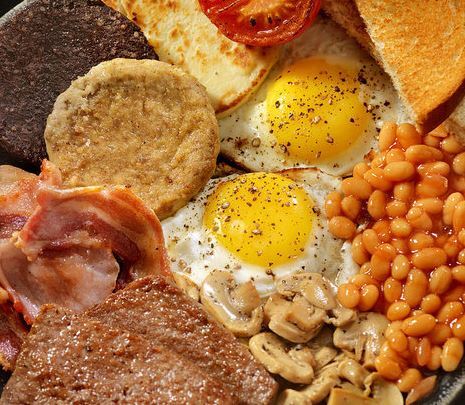
“Out with the Old, and in with the New!”
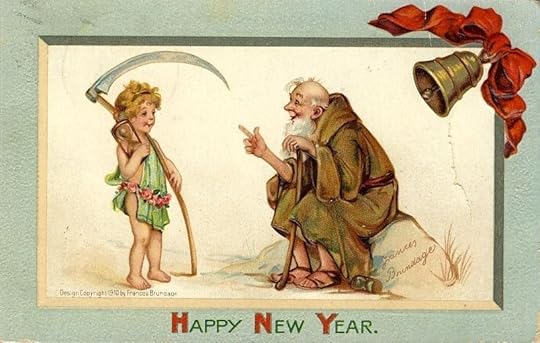
Scottish New Year’s Blessing

Happy New Year!

Arlene Stafford-Wilson
Honorary Life Member, Lanark County Genealogical Society
Member, Association of Professional Genealogists
Lanark County Pioneer Families Humanitarian Award
Author of : “Lanark County Christmas”, “Lanark County Comfort”, “Lanark County Collection”, “Lanark County Calling”, “Lanark County Classics”, “Lanark County Connections”, “Lanark County Calendar”, “Lanark County Chronicle”, “Lanark County Kid”, & “Recipes & Recollections”
and, “Lanark County Kitchen: A Maple Legacy from Tree to Table”
December 26, 2023
Perth Library – Heart of the Town
Although there was a reading room established on the main street of Perth in the 1800s, which featured current newspapers, books and periodicals, it wasn’t until the beginning of the twentieth century that a formal library building was constructed.
With the help of a large donation from the Andrew Carnegie Foundation, along with municipal and private funds, a library was built and opened to the public on Dec. 30th,1907.
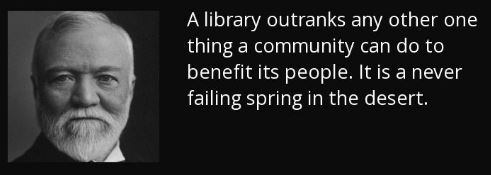
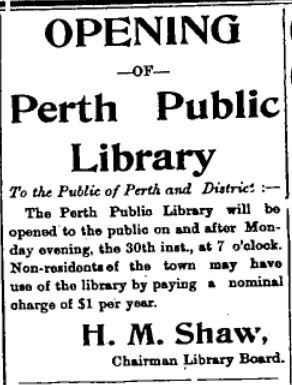
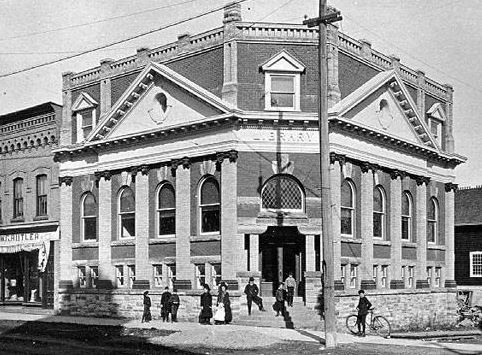
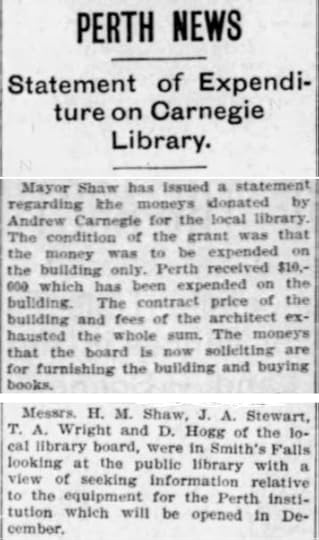
The Perth Library was one of five libraries in Ontario that was built using grants from American philanthropist Andrew Carnegie. Constructed from local rock and brick, the library was an impressive three story building gracing Gore Street near the Tay River canal.
No Smoking Rule – Jan. 1908
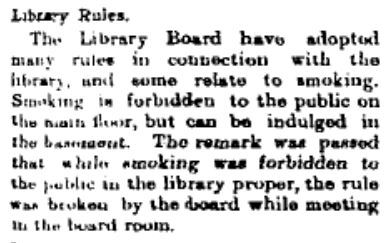
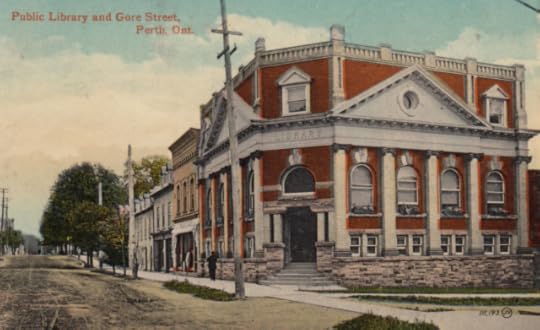
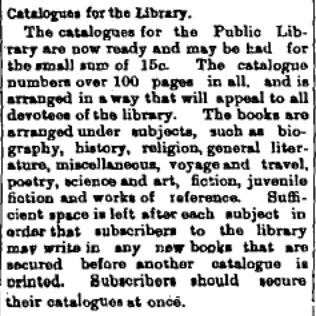
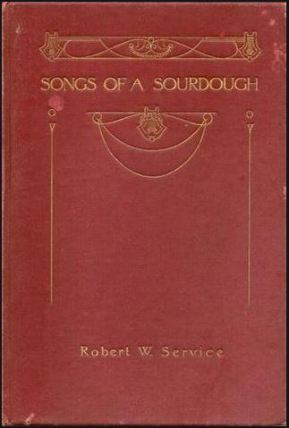

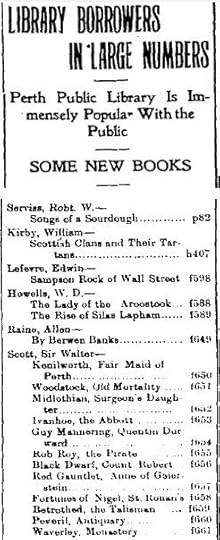

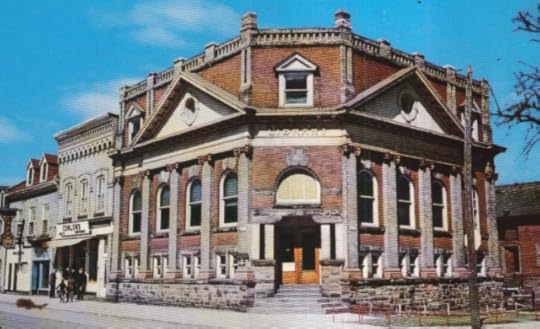
At at 7:15 p.m on Thursday, January 3rd, 1980, flames tore through the building. It was said at the time that the fire likely began in the basement.
“Shaking their heads in disbelief, Perth’s residents, both young and old, gazed yesterday at the gutted remains of their historical public library.”For over four hours a team of about 50 fire-fighters fought in freezing temperatures, and poured thousands of gallons of water into the building, through smashed windows and doorways.
Perth police constable, Bob Carnrite, said, “The cause of the fire is a mystery.”Water soaked books smoldered in the gutted building and nothing could be saved. Over 62,000 books along with paintings, antiques, maps and historical documents were lost.
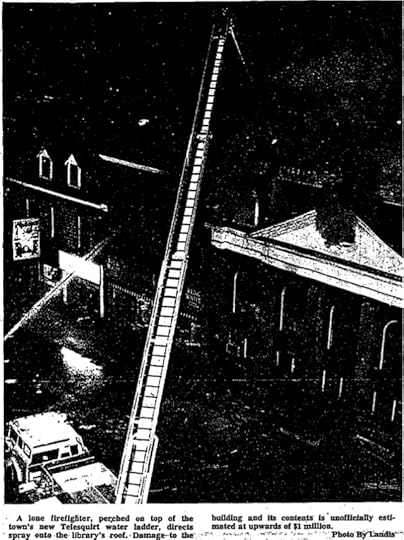

I recall the eerie sight of the building, familiar to so many of us, appeared like an ice castle because of the frigid temperatures, and the tremendous amount of water used to fight the fire.
“Every child is talking about it today.”, said Eve Dodge, Supervisor of the Perth Daycare Center. “Because of all the programs held there and their frequent contact, the library was a very important part of their lives.”It was a devastating loss to the town of Perth having been one of the loveliest buildings on the main street for so many decades.
“For this town, the library was the heart of the community.”It also meant job loss for Assistant Librarians, Susan Mackey, and Fay Cunningham.
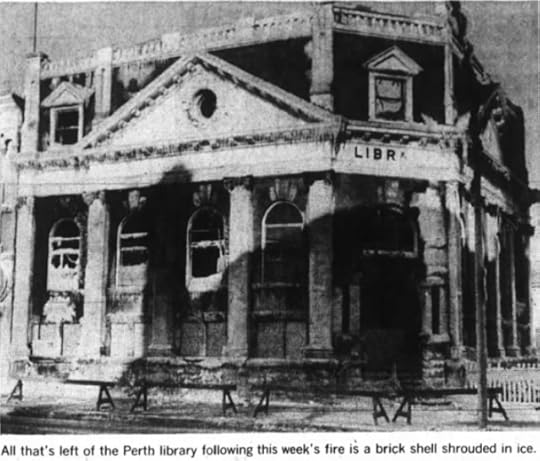
Harold Jordan, Inspector withe the Ontario Fire Marshall’s Office visited the site once the blaze was extinguished, and sifted through the ruins.
“I haven’t formed any conclusions yet”, Jordan said, “I’m considering every possibility. There are some indications the fire may have started in the basement, but I have no information at the moment which points the cause at anything other than accidental. Our minds are still open.”The inspection showed that no fuses in the library had blown, and that the fire had started in the basement.
Secretary Treasurer, Ivey Mather, said, the investigation continues….The Perth Public Library Board immediately began to find a temporary location for a public library.
The Board was offered space above the River Guild, and at St. James’ Hall, and even at the old Bell Telephone building.
“We could be back into circulation by next week.”, said Board Chairman, Bernard Elliot.
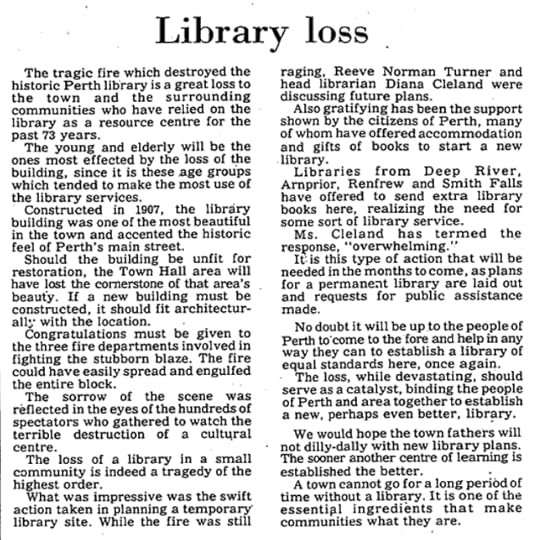
Other local libraries donated books and these were housed temporarily in the basement of McMartin House, and plans were quickly put into place to establish a new library.

The present library, on the corner of Herriott and Drummond Streets, was opened on December 16th, 1981.
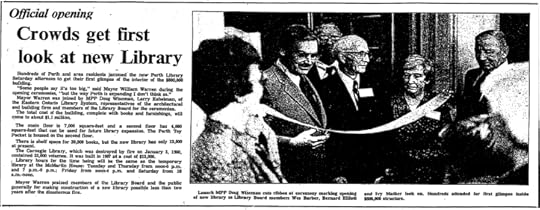
Photo: Lanark MPP Doug Wiseman cuts the ribbon. Library Board Members: Wes Barber, Bernard Elliot, and Ivy Mather.
The new building was constructed, at a total cost of $800,000.
(the original library in 1907 was built for $13,000)
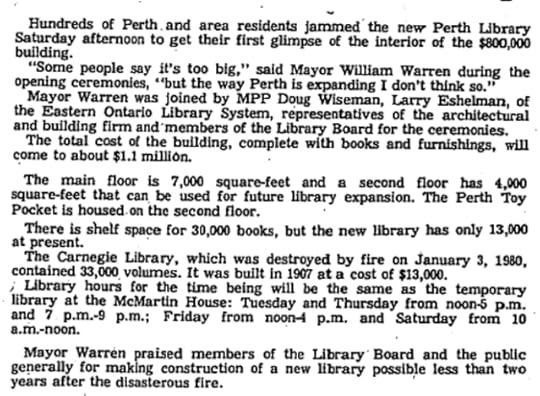
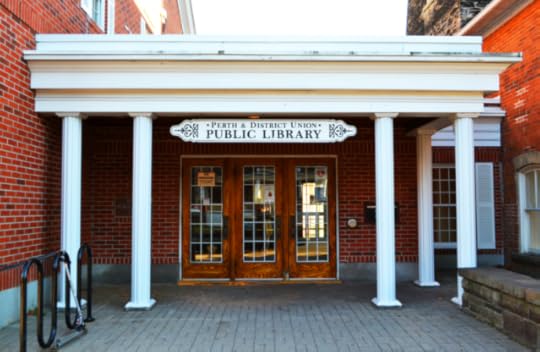
The ‘new’ Perth library is located at 30 Herriott St, Perth, Ontario – a beautiful setting, along the Tay River.
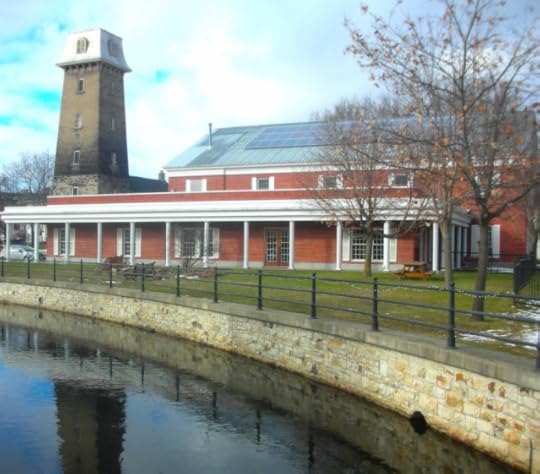
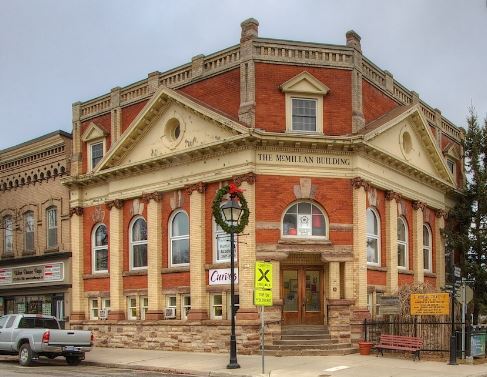
From its early days, beginning in 1907, with the first librarian, Hattie Nicoll, the Perth Library has served the community and surrounding rural areas.
For more information on the history of the Perth Library:
“Meet the dedicated staff of the Perth Public Library, who worked there in the 1960s, 1970s, 1980s, and beyond. Discover the tragedy, scandal, and unstoppable spirit that made this place ‘the heart of the town’.”
The story, “Perth Library: Heart of the Town”,“Lanark County Collection: Winding Our Way Down Memory Lane”…………
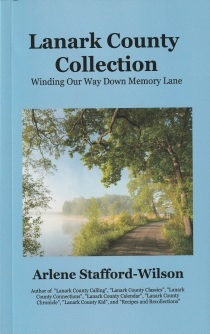
Arlene Stafford-Wilson
Honorary Life Member, Lanark County Genealogical Society
Member, Association of Professional Genealogists
Lanark County Pioneer Families Humanitarian Award 2023
Author of : “Lanark County Kitchen”, “Lanark County Christmas”, “Lanark County Comfort”, “Lanark County Collection”, “Lanark County Calling”, “Lanark County Classics”, “Lanark County Connections”, “Lanark County Calendar”, “Lanark County Chronicle”, “Lanark County Kid”, & “Recipes & Recollections”
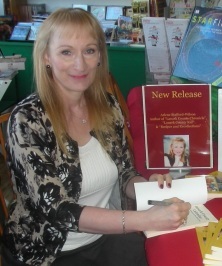
December 25, 2023
Christmas at the Stafford House
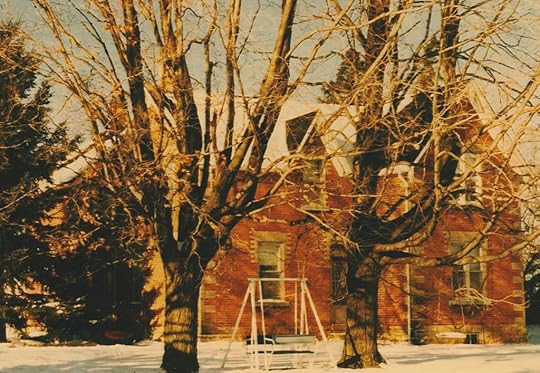


Judy: “Christmas Day in those days, as now, was a joyous occasion, but we knew that there would not be many presents because our parents couldn’t afford them, but there were second-hand sleighs or toboggans, and gifts that were hand-made or hand-sewn.”
Roger: ” I remember waking up and being able to see our breath Christmas morning. I remember moving wood, both at home and at school (S.S.#4 Bathurst), as both were heated with wood. Neither had running water. Water was pumped into a pail, and brought inside for drinking and cooking.”
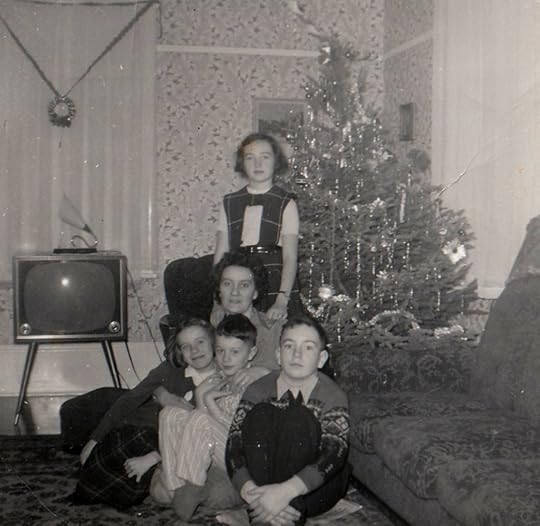
Judy Stafford (standing) Audry Stafford seated, front row, left to right – Jackie Stafford, Roger Stafford and Tim Stafford
Arlene: “One year Aunt Nellie Rutherford sent us a beautiful Christmas ornament. It was made of brass and had a circular base, with a brass rod that extended up from the base. Attached to the rod about halfway down were four angels with tiny rods hanging beneath each, and two bells extending out to the sides. On the base were holders for four small candles, and when you lit the candles the angels began to go around in a circle faster and faster, and their tiny rods would strike the bells and ring very softly. That was one of my favourite decorations. I also liked the little cone-shaped paper angels that hung on the tree, and the metal birds with tails made of real feathers that clipped onto the branches.”
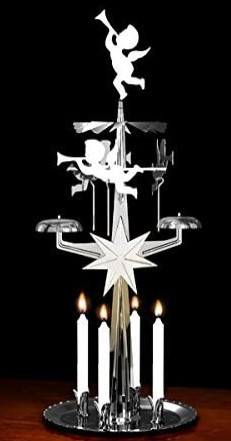
Roger: “I can also remember Mom and the girls putting the Christmas cards on strings and hanging them up for decorations. I can remember cutting up Christmas cards from the year before to make the tags for gifts. And there were the bells on the doors. I remember one on the door to the hall and I believe one on the front door. “
Jackie: “I think that at one time almost everything hung on the tree was homemade.”
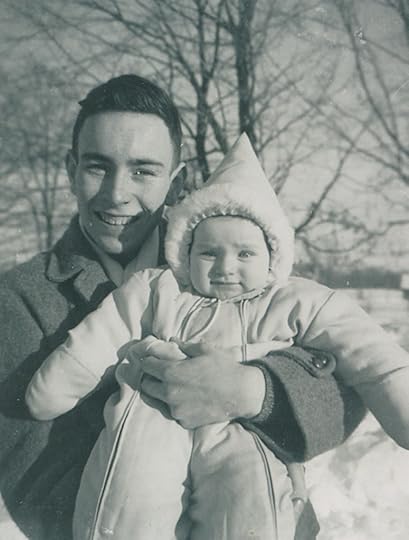
Tim Stafford with Arlene Stafford
Tim: “I was not able to sleep Christmas Eve. I had been warned several times that Santa would leave only potatoes in my stocking if I didn’t sleep. When I actually did get potatoes in my stocking when I was eight or nine years old I was in shock.”
Judy: “Oh yes, I certainly did get potatoes in my stocking…a very clear message on Christmas morning, and it was probably on more than one occasion. I wasn’t very surprised either! We were usually threatened and she always carried through. The only candy I remember getting in my stocking was hard candy, and there was always an orange in my stocking – that was a rare treat as fresh, imported fruit wasn’t usually seen at other times of the year. Soda pop would also be purchased, but only at Christmas.”
Jackie: “Mother would put our stockings at the end of our bed when she thought we were asleep, and sometimes we were. If we had been bad we would have a potato in our stocking, along with a piece of fruit and a bit of candy.”
Roger: “I can also remember getting a potato in my sock one year. Mother had warned me that Santa put potatoes in bad boys’ socks. It shouldn’t have been any surprise to me.”
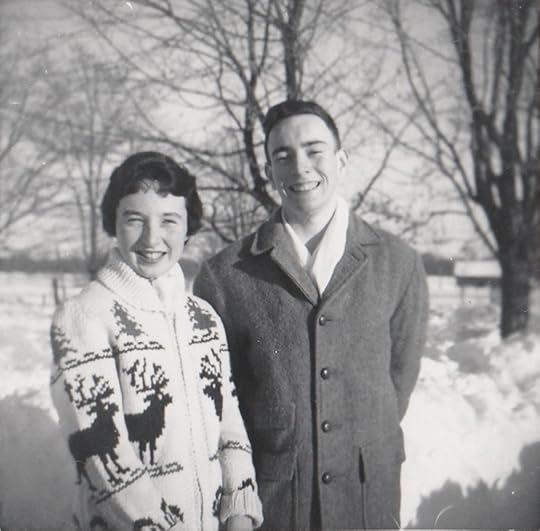
Judy Stafford and Tim Stafford
Judy: “We received what we considered very expensive gifts from our Uncle Jack Rutherford in Alberta, and were allowed to choose one gift to open on Christmas Eve, and we usually chose his. There was no ripping off of gift paper – the parcels had to be carefully unwrapped and ribbons, if any, had to be handed over to Mother before they could get mixed up with the discards and boxes, which would be thrown in the cook-stove to burn.”
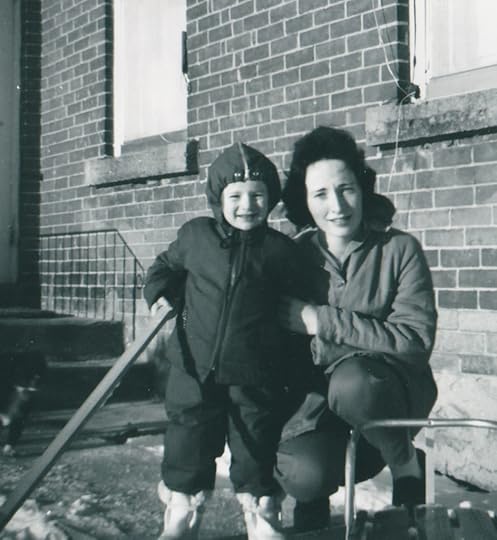
Arlene Stafford and Judy Stafford
Arlene: “I was always excited to go to Calvin Church, on Christmas Eve. During the service I would usually be whispering to my friends Susan and Jane Munro, who sat in the pew in front of us, until Mother would give me ‘the look’ and then I would try to be quiet. It wasn’t easy being quiet because I knew so many of the kids there. Looking around the church I saw lots of my friends from school – Patti Jordan, Jutta and Judy Siebel, and Barb Patton. George Jordan and I were in the same grade, Steve Scott, Harold Closs and Bobby Miller were a grade ahead of me, and then there were the older girls who were a little bit farther ahead in school like Janice Jordan, Karen Jordan and Maxine Closs. After church was over, I would see my friends outside and we’d be talking excitedly about what gifts we were hoping to find under the tree the next morning.”

Jackie Stafford and Tim Stafford in front of the Stafford House
Judy: “Parcels from the West, or also known as the ‘hand-me-down box’, would arrive from our Aunts in Alberta, twice a year, with our cousins gently worn clothing – every summer a box of winter clothes, and every winter, just before or right after Christmas, a box of summer clothes arrived. This was always an exciting time when we would crowd around Mother as she opened the box, and decided who would get what, and if any of the clothing had to be altered to fit us. I remember a lot of the dresses being brown which was not my favourite colour, but I imagine they were practical as they would not show the dirt. Mother also made dresses and blouses and skirts – shirts for the boys. I remember a lovely lilac plaid summer dress Mother made for me, and an identical one in pink plaid for Jackie. Our shoes were purchased from a factory outlet store in Lanark, and we made that trip a couple of times a year to buy shoes for school. “

Tobias ‘Tim’, ‘Tib’ Stafford checking the Christmas lights on the spruce tree
Roger: “Dad always put lights up outside, usually on the spruce tree near the door. I often watched the northern lights dancing, or heard the whistle of the train at the crossing back of the house, or the sound of the train itself on a cold winter night. I guess those are a couple of the reasons that cities have no attraction for me.”
Judy: “Nothing these days will ever replace the sound of the train whistle as it passed back at the tracks around midnight every night, or the sounds of the sleigh runners cutting through the snow on a crisp winter’s night.”
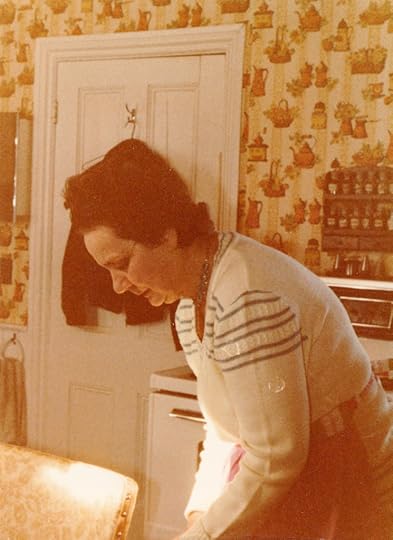
Audry (Rutherford) Stafford, in the kitchen, preparing some Christmas treats
Mother’s Chocolate Fudge
2 Tbsp. butter
2 c. miniature marshmallows
1 1/2 cups of chocolate chips
2/3 cup evaporated milk
1 tsp. vanilla
1 2/3 cups of sugar
1/2 cup chopped walnuts (if desired)
1/2 tsp. salt
Mix butter, milk, sugar and salt in a saucepan, and bring to a boil. Cook for 5 minutes, stirring constantly, then remove from heat..
Stir in marshmallows, chocolate chips, vanilla and walnuts.
Pour into an 8-inch buttered pan. Cool. Cut into squares. Makes 2 lbs.
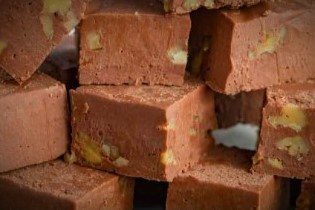
Tim: “My favourite Christmas food – Chocolate fudge with walnuts.”
Roger: I certainly remember all the toffee and fudge Mom used to make at Christmas. Mother also baked many specialty cookies for Christmas. As Christmas approached mother would review her stock in the freezer only to find much of our favourites had disappeared. I can remember holding the door while one of my siblings with longer arms would lean in and load up on treats from the freezer. I was never averse to a sweet bribe.”
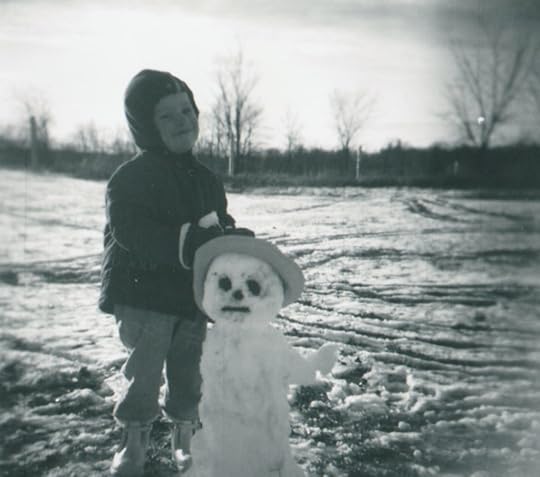
Arlene Stafford making a snowman
Jackie: “When I was a kid, Mother bought her Christmas candy through the catalogues – Sears and Eaton’s and bought medium size boxes of licorice all-sorts; bridge mixture; and the cinnamon candies. I think she probably bought other types as well but I remember the ones I liked. She hid them in the bedroom, and then, closer to Christmas, in the pantry somewhere, and she would go in there now and then with an empty bowl, and magically come out with a bowl of one of those candies. A great treat because we rarely had that kind of ‘bought’ candy.”
Roger: “I also remember that Mother would always buy some grapes and Christmas oranges for a special treat at Christmas. It makes me feel very lucky to be able to go buy any type of fruit all year long.”
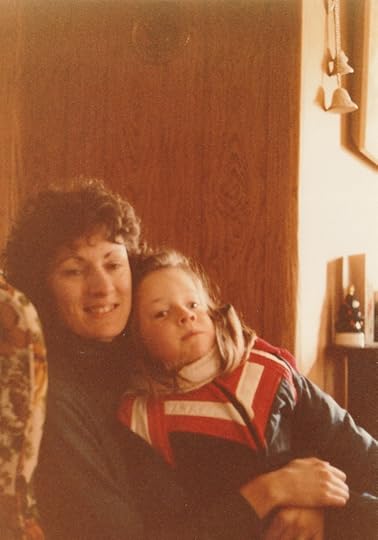
Jackie Stafford with niece, Andrea Ryan, eldest daughter of Judy Stafford Ryan
Jackie: “Christmas Eve was always an interesting time. Dad would be late from work, delivering milk for Chaplin’s Dairy, and Mother would usually let us eat at the usual time as she was never sure when Dad would turn up. When he did come home, he was tired and he had a bag of stuff with him. While he ate his warmed up dinner Mother would open all of the presents he got from his customers.”
Arlene: “Dad used to get five or six boxes of chocolates from his customers. I was always hoping that he would get a box of chocolate covered cherries. They were my favourite.”
Roger: “I remember Dad bringing home Christmas cards from his customers in Perth, on the milk route, and Mom opening them up and taking the cash out to put towards a summer holiday.
Jackie: “On Christmas Eve Dad’s customers would often give him money – usually $1 or $2 dollars and Mother would have little piles of bills. Sometimes they would know his brand of cigarette and those were great, but the Export A and Players were traded at his favourite store, if possible. I would love those because we would get the empty tins and I would love to put my crayons in one and some little bits in pieces in another. He also got single packs of cigarettes and they were often his brand.”
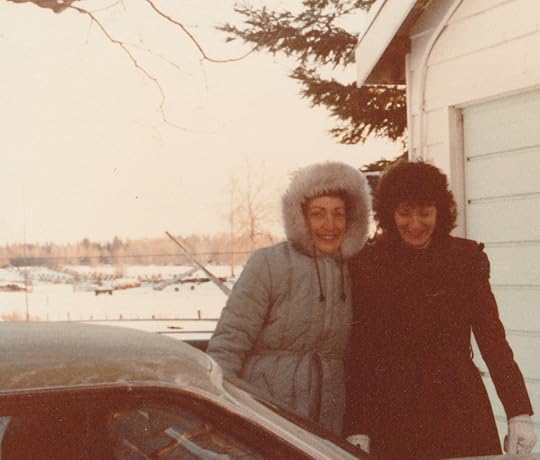
Judy Stafford and Jackie Stafford
Judy: “I remember that Mother didn’t like anyone in the kitchen when she was cooking, and when we were older and came home at Christmas, she would post a list of duties for each of us on the refrigerator.”
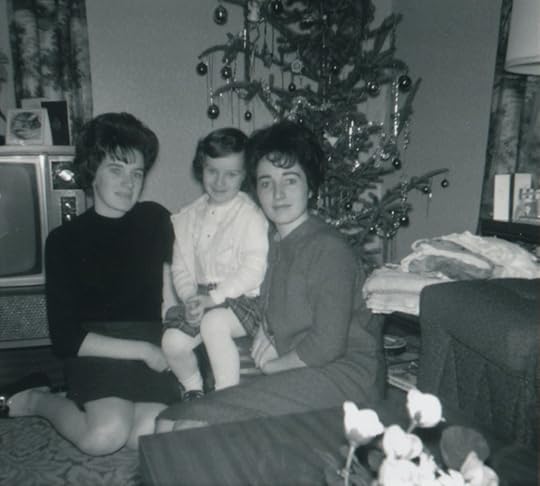
Jackie Stafford, Arlene Stafford, and Judy Stafford
Jackie: ” One Christmas, there was a toboggan under the tree for me. Tim already had one, which was a good size, but mine was smaller, and perfect for me. We couldn’t wait to get outside and try it. In those days, there was a lovely hill to the right of the house, part of the land surrounding the barn. We would slide down the hill, and if you went through the gap you ended up in the next field.”
Roger: “I can remember one year, that Uncle Jack Rutherford, sent Jackie and I, aluminum snow-shoe-shaped sliders. We used to try to slide down the hill near the barn, standing up. We seldom succeeded.”
Judy: “We skated and tobogganed. We went down the hill in the field beside the house, and over a low fence, and that caused a few accidents!”
Tim: “In the early part of the winter, if there was a cold snap and not too much snow, the creek would freeze over and I would skate to school (S.S. #4 Bathurst), passing all through the farms, and coming out at the bridge just south of the school. On days when the ice was too thin, I would arrive home soaked to the knees, and Mom would have to dry all of my clothes as best she could on the wood-stove oven door, as there was no clothes dryer then. The skates I used were Dad’s, with extra socks in them.”
Jackie: “We skated until our feet were so cold that we could not get our skates off, so when we were small, we just walked home in them. Mother would get the skates off, and we would sit in front of the open oven door to thaw out our feet.”
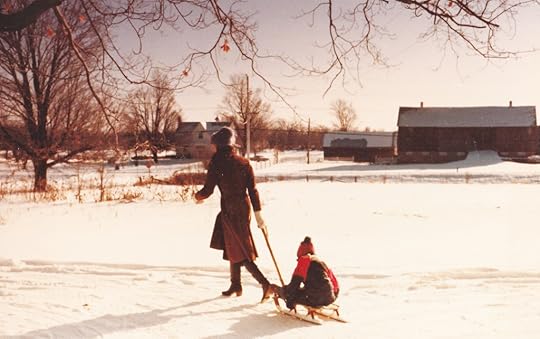
Jackie Stafford, and niece, Andrea Ryan, in the front yard, Korry’s farm in the background.
Jackie: “When we were old enough Dad would let us go with him to get the Christmas tree. As we got older we would sometimes have already selected a few possible trees for Dad to look at. In the early years we walked back to the bush and brought the tree back on Tim’s toboggan. I was always half frozen by the time we got back home.”
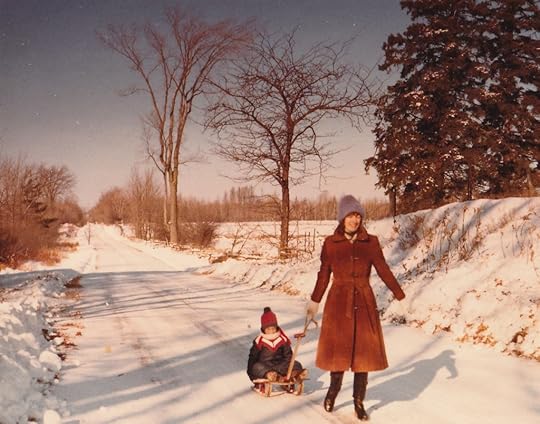
Jackie Stafford, pulling niece, Andrea Ryan, on a sled, on the side road, near the house.
Roger: “I can remember trying to find a nicely shaped tree that wasn’t too big, and then getting home and finding it was still too large to go in the house. At one time I can remember Dad nailing a large board to the bottom of the tree to stand it up. That was before we had a Christmas tree stand. I can remember Mom having us check the stand for water to make sure the tree wasn’t drying out too fast. I can also remember all the needles falling off when the decorations were being taken off the tree, and the tree was taken out through the kitchen to the yard. I can remember Mom using some of the boughs cut off to make a wreath.”
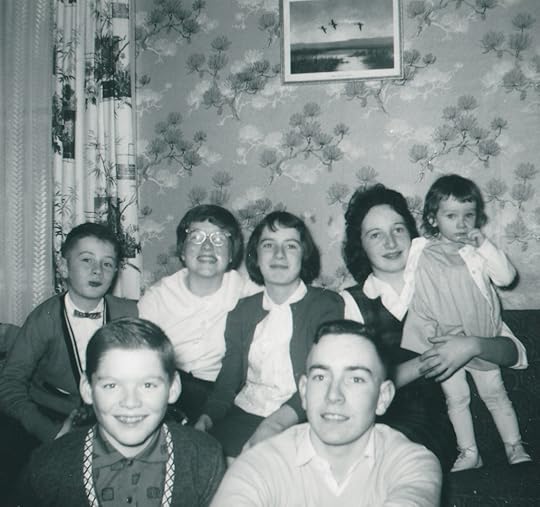
Back row: Roger Stafford, cousin Gail Stafford, Jackie Stafford, Judy Stafford, Arlene Stafford. Front row: cousin Peter Stafford, Tim Stafford
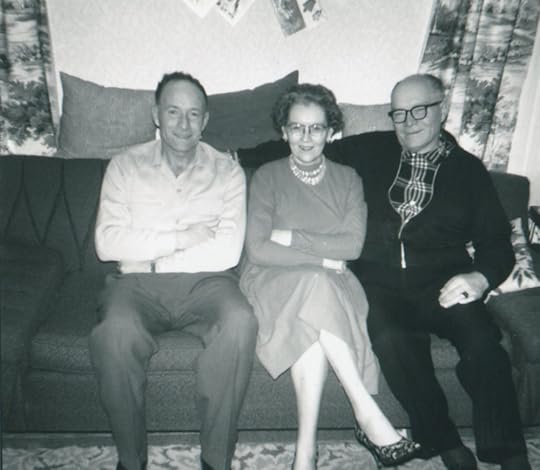
Tobias ‘Tim’, ‘Tib’ Stafford, his sister-in-law, Aunt Pat Stafford, and his brother, Peter ‘Pete’ Stafford
Jackie: “In those days Mother made popcorn, and we strung it on string, and used that as a garland on the tree.”
Roger: “I can also remember stringing popcorn for decorations.”

L to R: Roger Stafford, Arlene Stafford, Judy Stafford, Audry Stafford, Tobias ‘Tim’ Stafford, Tim Stafford, Jackie Stafford
Jackie: “Mother bought coloured craft paper, and we cut out strips of paper and glued them together to make a circle, and then a circle within the previous circle, and on and on, until we had a string long enough to go from the corners of the living room to the light fixture in the center of the ceiling. We usually did them red, green, etc.”
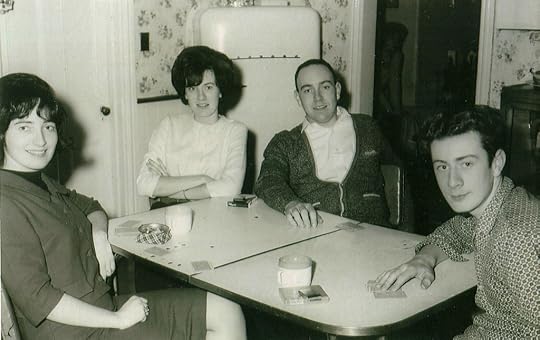
L to R: Judy Stafford, Jackie Stafford, Tim Stafford, Roger Stafford
Arlene: “Board games, and card games were a favourite on Christmas night, after dinner. Everyone gathered in the kitchen, and Mother brought us bowls of fudge, taffy, cookies, and sweet squares. We played Rummy, Monopoly, and sometimes Crokinole, until the wee hours. Mother always bought soft drinks at Christmas, sometimes cola, orange, or root beer. That was the only time of the year we had pop in the house.
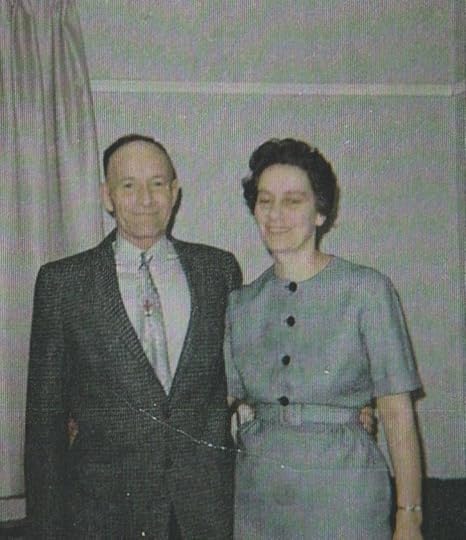
Tobias ‘Tim’ ‘Tib’ Stafford and Audry (Rutherford) Stafford, 1968
Judy: “Before the day was out, our Mother would iron the Christmas paper and ribbon, which would be carefully tucked away until next year. To this day, I cringe when I see anyone rip off gift paper with no thought of re-using it. We often made our own Christmas wrapping paper in those days, using cut-up brown paper bags, and drawing pictures on with crayons, and tying up the gifts with binder-twine. We were always appreciative of what we received, because wealth to us was being happy and healthy, with loved ones around to share the joy.”
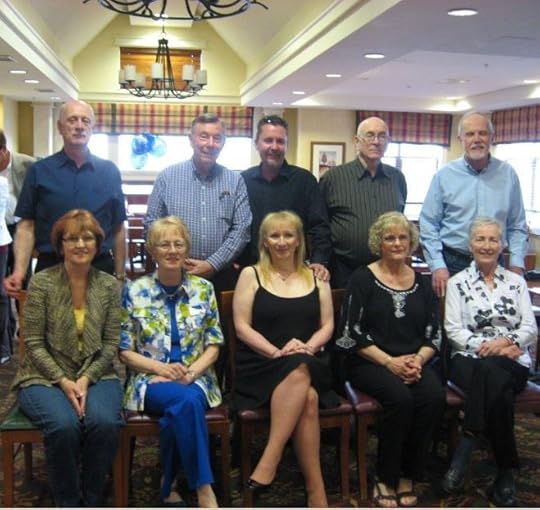
The Stafford siblings, with their spouses: Back row- Roger Stafford, Sam Wharton, Kevin Wilson, Tim Stafford, Jim Ryan. Front row: Ruth (Parks) Stafford, Jackie Stafford Wharton, Arlene Stafford-Wilson, Marian (Salemink) Stafford, and Judy Stafford Ryan.
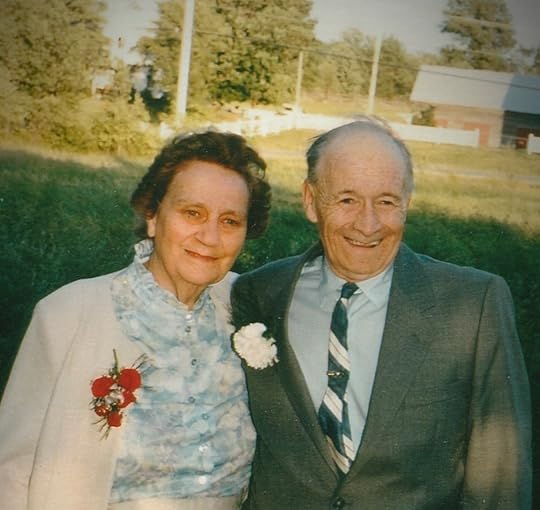
Audry (Rutherford) Stafford 1919-2007, Tobias ‘Tim’ ‘Tib’ Stafford 1918-1992
…..and so we’ve come to the end of our Christmas visit to the Stafford House. If you had spent Christmas Day with us you would have never guessed that we didn’t have very much money. Our dinner table was overflowing with food – a huge platter of turkey, bowls heaped with stuffing, a basket piled high with soft homemade dinner rolls, steaming mashed potatoes, gravy, cheese, and pickles, and that was just the main course.
For dessert there was homemade Christmas fruit cake, shortbread, chocolate chews, cherry balls, gumdrop cookies, almond cookies, shortbread, sweet squares, chocolate fudge with walnuts, homemade toffee, licorice all-sorts, bridge-mixture, mixed nuts, and boxes of assorted chocolates.
The Stafford house was filled with laughter, and multiple lively conversations. There were chiming bells attached to the front door and hall door, and Christmas cards displayed, framing every doorway and covering every flat surface in the living room. A fragrant fresh-cut spruce tree graced the corner of the living room, proudly displaying our homemade ornaments, and a few precious glass balls that Mother had saved over the years. Our opened gifts were nestled under the tree, along with the remnants of our stockings from that morning.
By the evening, Mother would be resting on the couch, and Dad would be lounging in his lazy-boy chair. They often discussed the events of the day, while sharing a box of chocolates Christmas night – she preferring the hard toffee centers, and Dad enjoying the soft creams, which worked out very well indeed, over their many Christmases together.
You would have found the Stafford children in the kitchen, playing cards, or board games, sharing a dish of fudge, a bowl of nuts, and some homemade cookies. We’d often be sporting the paper crowns from the Christmas crackers we’d pulled at dinner time. You would have heard genuine shrieks of laughter, and some friendly jabs, many hilarious jokes from Roger, and witty remarks from Tim, with his dry sense of humour. You’d likely hear the girls scolding the boys for some of their occasional off-colour comments, followed by more laughter, and a few groans, as we all complained about how much food we’d consumed, all the while everyone agreeing how delicious it was.
As Christmas Day wound down for another year, one at a time, people began to trail off to bed, weary from the fresh cold air and outings during the busy day, and stuffed full of our Mother’s delicious food.
We hope you enjoyed hearing our stories about growing up, at the Stafford house, and the ways we spent Christmas Day. The sights and sounds and smells from our childhood Christmas are something we carry with us every day. They lift our spirits in times when life seems cold, and harsh, and unforgiving. We need only to close our eyes and we are back on the Third Line, walking up the lane, through the yard, and entering the bright, warm kitchen. We are home again.

Quotes and stories from Tim Stafford, Judy Stafford Ryan, Jackie Stafford Wharton, Roger Stafford, and Arlene Stafford-Wilson, and the recipe for Audry Stafford’s Chocolate Fudge, are excerpts from, “Recipes and Recollections: Treats and Tales from Our Mother’s Kitchen”
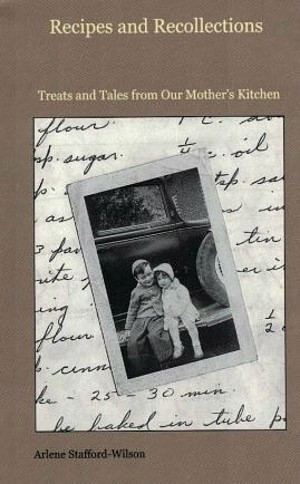
*
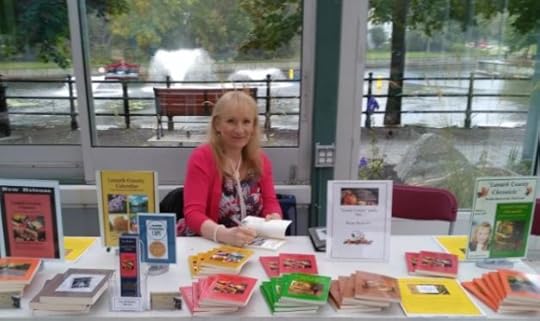
Arlene Stafford-Wilson
Honorary Life Member, Lanark County Genealogical Society
Member, Association of Professional Genealogists
Lanark County Pioneer Families Humanitarian Award
Author of : “Lanark County Christmas”, “Lanark County Comfort”, “Lanark County Collection”, “Lanark County Calling”, “Lanark County Classics”, “Lanark County Connections”, “Lanark County Calendar”, “Lanark County Chronicle”, “Lanark County Kid”, & “Recipes & Recollections”
and “Lanark County Kitchen: A Maple Legacy from Tree to Table”
December 24, 2023
Finding the Spirit of Christmas in Lanark County

The glass felt cold as I pressed my face against the kitchen window, and watched the snowflakes falling softly on the spruce tree beside the old house. The Christmas lights were wrapped ‘round and ‘round the tree, and the soft colours shone on the snow-covered branches below.
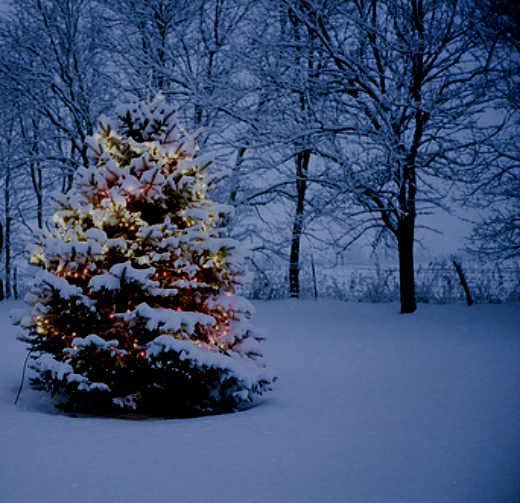
It was Christmas Eve, the most magical night of the year, and I was bursting with anticipation. Santa was coming tonight, and would surely be leaving some wonderful gifts under the tree in the living room. I had been very good all year, and had written a letter asking for a lovely new doll with long red hair and big blue eyes. I stared up at the night sky, white with snow and wondered where Santa was? Was he in Lanark County yet, or was he delivering his toys to children in other parts of the world, along his route? Hal Botham, on CJET radio, said that Santa’s sleigh was spotted up north, so I was sure that he must be on his way to the Third Line!


Supper was finished, and Mother was tidying up the kitchen. Soon, we’d be heading over to Calvin Church for their candlelight service. Every year we were allowed to open one present after returning from church, and then we had to head straight to bed, and go right to sleep, so that Santa could deliver our gifts.
When Mother was finished sweeping the floor, we put on our coats and boots, and headed outside. The old car was chilly, and the heater was blowing cold air. I shivered as we headed down the lane, and up the Third Line, toward DeWitt’s Corners.
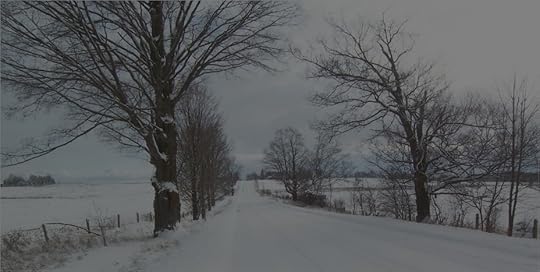
Everyone’s Christmas lights glowed on that night so long ago. The pine tree in front of Chris and Leanore Perkins’ house was decked out in blue lights, and Korry’s had red and green lights framing their front door. The Mitchell’s, Conboy’s and Scott’s all had lovely bright lights, and we passed by house after house, all aglow in their Christmas finest. Then we slowed down, and turned up Cameron side road.
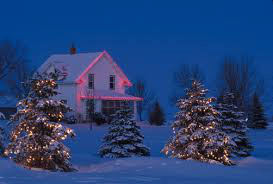

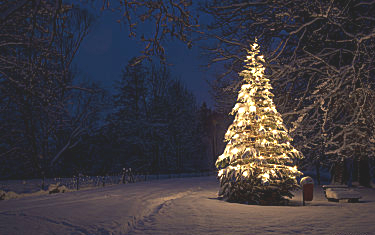
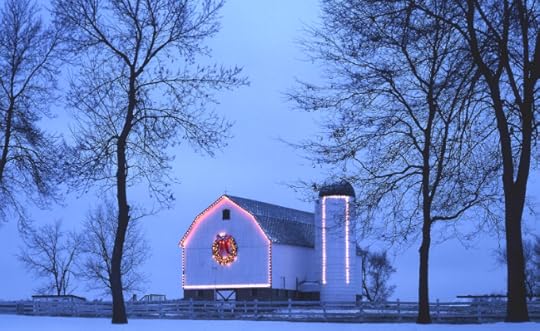
When we finally arrived at the church, there were only a few cars parked, and some people had already gone inside. The light coming from the little country church glowed softly against the cool white snow, and the delicate flakes continued to swirl around as we parked, and Mother shut off the engine. When I opened the car door the church yard was silent. The snow continued to drift down softly, and as I stood there I listened, but couldn’t hear a thing. We didn’t speak as we walked up to the church, and I’ll never forget how calm and peaceful it was that night as we walked up those well worn steps.
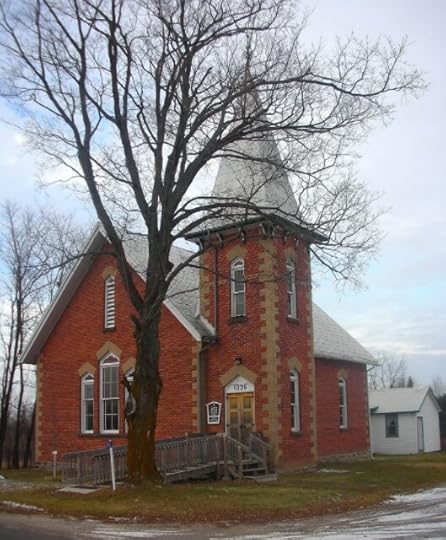
We sat in our usual pew with the Korry family, behind Wilma and Clarence Munro’s, in front of Betty and Ivan Johnston’s, and in the next little while familiar faces appeared again and again at the doorway of the church, filed in, and took their seats. Many stopped to chat on the way to their pews. They were our neighbours, our classmates from Glen Tay School, and our good friends. As I looked around at all of their faces I realized how special it was to be there that night, and to be a part of this close community.
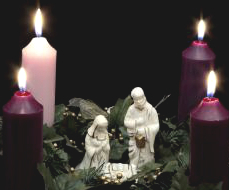
When everyone was finally seated, and it seemed like the little church couldn’t hold even one more person, the sounds of the organ filled the air, and the old wooden pews creaked as everyone stood up at once. The song was a familiar one; we all knew the words, and our voices swelled in unison as we sang the ancient carol, “Si..lent night……., Ho..ly night………, All is calm……., All is bright.”
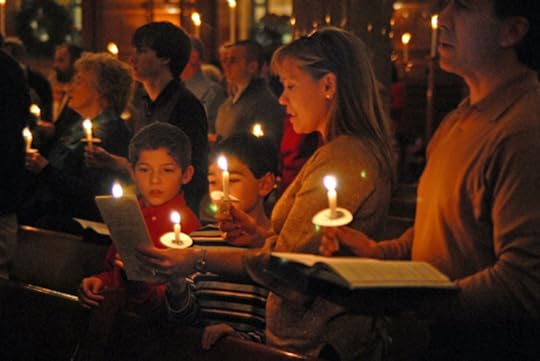
On that special evening familiar carols were sung, and the story of the first Christmas was told once again.
…
And so, that was how Christmas unfolded out in the country. The days and months leading up to that evening were filled with anticipation. Trees were trimmed, and cards were mailed. Letters to Santa were written, and toys were circled in pen, in the Sears Christmas Wishbook. We rehearsed for Christmas concerts, and ran down the lane each day, bringing back handfuls of Christmas cards, adorned with stickers and seals. Cookies were baked, and invitations went out to family members and friends, to come and spend the day.
All of these things played their part leading up to the most special day of the year; but it was not until we sat in the pews of the small country church, and raised our voices, singing our favourite carols, that I knew for sure that the spirit of Christmas was among us.
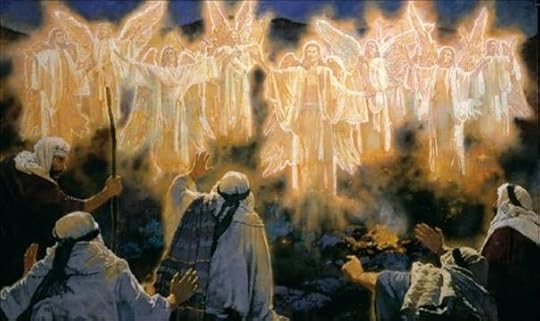
I knew from an early age that the spirit of Christmas didn’t live in the beautifully decorated store windows in Perth, or under the brightly lit tree in our living room. I still don’t know how the Christmas Spirit found us, in the little church……….all the way out in the country.
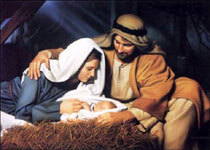
All I know is every year it appeared on Christmas Eve without fail. I could see it in the faces around me, I heard it as we sang the carols, and our voices rose high into the old wooden ceiling. It warmed our hearts, filled us with pure joy, and a profound sense of peace.

If you ever find yourself searching for the Christmas spirit, I’ll tell you where it is. Just drive out the Third Line on Christmas Eve, to the little country church on Cameron side road. It’s the small red brick church at the top of the hill. Go ahead inside, and then wait. You’ll feel it. It will be there. It’s always there; and even if you live far, far, away, you can take it home with you, keep it in your heart, and it will stay with you forever.
May the Christmas spirit be with you, wherever you find yourself, on this very special night!
……………………….

Some of the faces I remember on Christmas Eve, at Calvin Church:
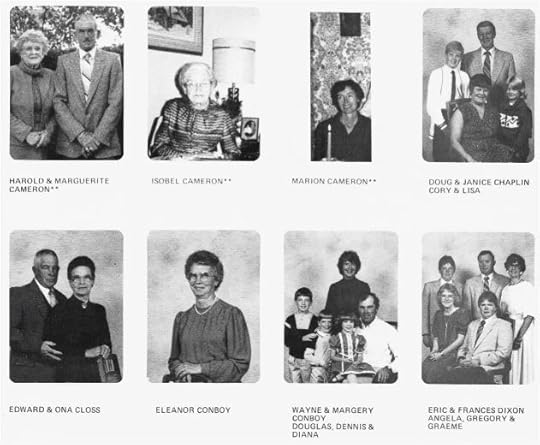
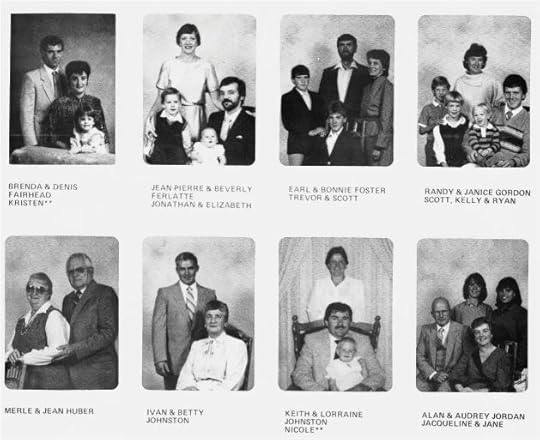

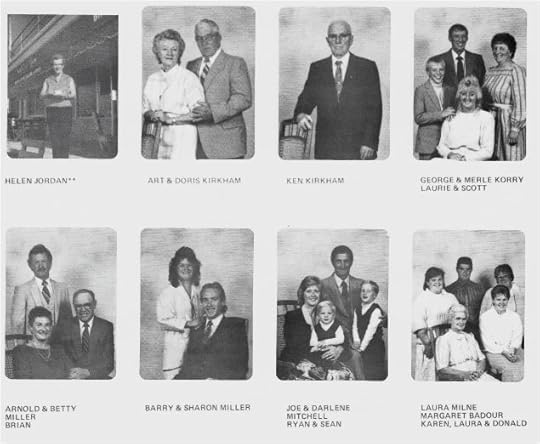
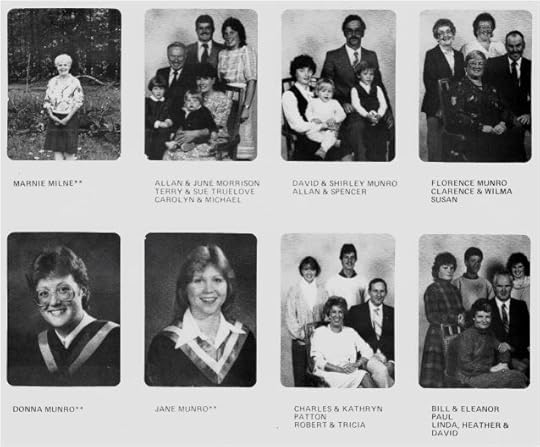
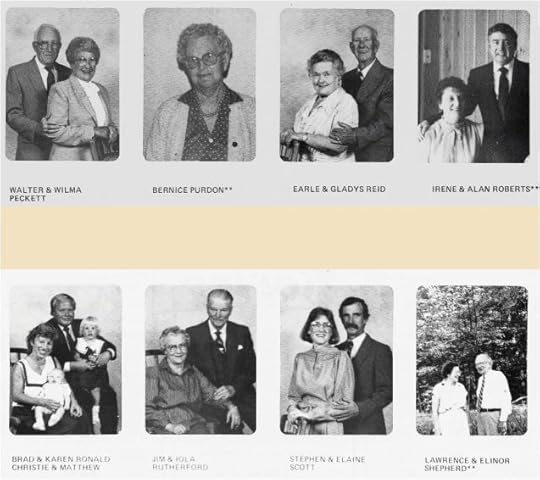

Some are gone, none are forgotten.
………………….

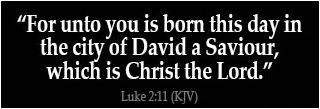
…………………………….
Calvin United Church was opened for worship in September of 1896, built on the property of Mr. John Cameron. The first elected officers in the church were Andrew Gamble, William Scott, Andrew Palmer, George Miller, Andrew B. Miller, Andrew W. Miller, W.J. Palmer, John Jordan, Nichol Stewart, Alex Palmer and Sydney Miller.
…………………………..
To learn more of the history of Calvin United Church, Cameron Side road, DeWitt’s Corners, Tay Valley Township, Lanark County:
History of Calvin United Church
“Finding the Spirit of Christmas in Lanark County”, an excerpt from “Lanark County Calendar: Four Seasons on the Third Line”
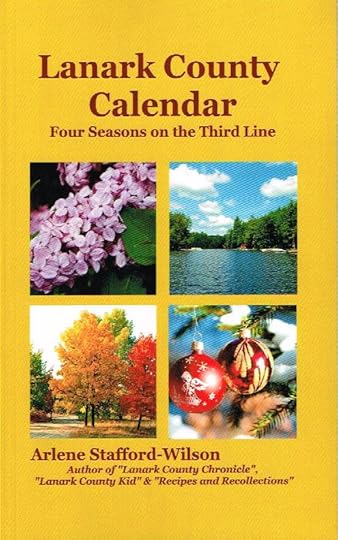
*

Arlene Stafford-Wilson
Honorary Life Member, Lanark County Genealogical Society
Member, Association of Professional Genealogists
Lanark County Pioneer Families Humanitarian Award 2023
Honorary Life Member, Lanark County Genealogical Society
Author of : “Lanark County Christmas”, “Lanark County Comfort”, “Lanark County Collection”, “Lanark County Calling”, “Lanark County Classics”, “Lanark County Connections”, “Lanark County Calendar”, “Lanark County Chronicle”, “Lanark County Kid”, & “Recipes & Recollections”
and, “Lanark County Kitchen: A Maple Legacy from Tree to Table”

